4 Volumes
Regional Overview: The Sights of the City, Loosely Defined
Philadelphia,defined here as the Quaker region of three formerly Quaker states, contains an astonishing number of interesting places to visit. Three centuries of history leave their marks everywhere. Begin by understanding that William Penn was the largest private landholder in history, and he owned all of it.
Culture: The Flavors of Philadelphia Life
Philadelphia began as a religious colony, a utopia if you will. But all religions were welcome, so Quakerism mainly persists in its effects on others, both locally and in America, in Art, clubs, and the way of life.
History: Philadelphia and the Quaker Colonies
Philadelphia and the Quaker Colonies
Nineteenth Century Philadelphia 1801-1928 (III)
At the beginning of our country Philadelphia was the central city in America.
Architecture in Philadelphia
Originating in a limitless forest, wooden structures became a "Red City" of brick after a few fires. Then a succession of gifted architects shaped the city as Greek Revival, then French. Modern architecture now responds as much to population sociology as artistic genius. Take a look at the current "green building" movement.
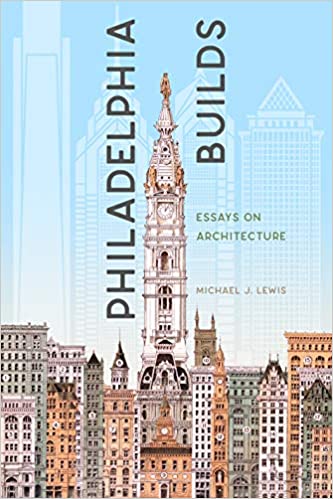
A new book is out that I recommend: Philadelphia Builds
Architects quickly tell you that spending extra money to make a building "green" is most popular with institutions, like hospitals, schools, and museums which expect to remain functionally unchanged for the next fifty years. It costs extra money to build a building which will last, and extra investment is needed to introduce all those good green things which will reduce the costs of maintenance. So you want to have confidence you will remain in the building longer than the 11 to 14 years it takes to pay off the initial cost. Anybody can see the sense of substituting fluorescent light bulbs for incandescent ones, because you will be money ahead in six months. But most of the rest of these green proposals encounter significant resistance from commercial tenants who are only somewhat confident they will be using a particular building five years from now. Even if wildly successful, a business will wish to move upscale, and if unsuccessful will close down. As far as housing is concerned, there is the same dream of moving upscale, balanced only by the possibility of moving away to a better job opportunity. We are no longer a farm community, or even a city of local professionals. Yes, it is possible that landlords of high-rise apartments may devise ways to pass long-term economies along to successive tenants. But this green thing isn't all that certain to work; the price of oil could drop enough to make green investment worthless. The logical place to start the experiment is with institutions, followed by professionals and cultural groups with a long tradition of local stability. In a word, Quaker churches.
Looking at it from the other direction, Philadelphia has a large number of very solid masonry houses which are under-occupied, hence cheap. Some of this traces back to the major fires of the Eighteenth Century, which resulted in zoning codes prohibiting wooden structures even at the Eastern edge of a limitless forest. Some of it reflects the sheet of bedrock, called Wissahicon Schist, which underlies the city from the old Naval Yard up to the point it breaks out on the surface in Chestnut Hill. New Jersey, over the river, is built on sand or at most blue marl clay, so it still favors frame houses. And the automobile tended to depopulate the grand old houses of Philadelphia, so big solid houses are available for restoration and renovation at half the price of building new houses which would probably be less substantial. There's also the remarkable fact that many old houses were built before central heating became popular, so they even survived without termite infestation in the swampy area between two rivers. So, circumstances made it attractive to renovate and make available a lot of big, cheap, very durable houses. That largely means nothing to prospective new industries, and there are the contrary factors of high crime and taxes, and poor public education. So, a process of social Darwinism takes over, encouraging the growth of a population which can ignore those factors while taking advantage of the long-term economies of durable permanent housing. The prospects for this transformation are slow and discouraging, and unfortunately will remain struggling until a population enthusiastic about our local advantages somehow achieves enough political influence to tip the balances. Low crime rate, low taxes, and good schools. Is there anyone opposed?
Recently, a sample of practicing Philadelphia architects were asked to name the handful of most influential architects in Philadelphia's past. The names repeatedly offered began with Smith, and then Latrobe, Strickland, Walter, Furness, Eyre, Howe, Giurgola, Kahn and Venturi. As you walk around Philadelphia, these were the sources of what makes the City look uniquely different, whether by building, or by influencing other architects to build in similar style. Let's look them over.
The Nation's Capitol
George Washington had been trained as a surveyor, created a rather handsome house in Mt. Vernon,

|
| Thomas Ustick Walter |
and had the new capital city, both located near his home and named after him. It is clear that ideas for the design of the new city and its major public buildings were brought to him for approval, and very likely adjusted themselves to his stated preferences. In the dedication ceremony, just about every political figure, dressed in Masonic costume, was lined up in two lines, which parted to allow Washington in full Masonic regalia to march majestically forward to lay the cornerstone with proper Masonic rites. Let there never be any doubt that it was his capital, in his capital.
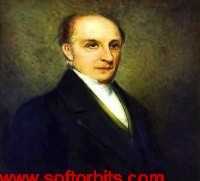
|
| Charles Bulfinch |
The man who actually drew up the original design and oversaw the construction was Charles Bulfinch of Boston. The Bulfinch style was clearly evident by comparison with the rather bulbous dome which echoed the "Ether Dome" of the Massachusetts General Hospital. Both domes were made of wood, and the invading British army of the War of 1812 made short work of the Congressional dome. Most of the more detailed work of the building is attributed to Benjamin Latrobe in Philadelphia, and much of the classical style reflected the classical style favored by Jefferson, and much promoted by William Strickland, a Philadelphia trainee of Latrobe. The genius of total re-design along modern lines was the work of one of Strickland's Philadelphia trainees, Thomas Ustick Walter.
The capital
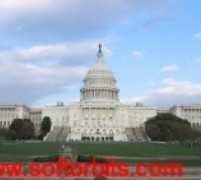
|
| The Capitol Building |
was too small, inadequately Roman Classic, and had an unacceptably burnable wooden dome, which was also too small. If the building was to be enlarged to its necessary size, the Bulfinch dome would be far too small, looking from afar like a Turkish pimple on a massive Roman auditorium. Walter proposed a technical solution: build the dome of cast iron. Transforming the North and South wings into mere galleries leading to much more massive Senate and House chambers, the whole building grew to usable size. All of this work nearly came to a stop in the Civil War, but Lincoln made the decision that the symbolism of continuing on was more usefully dramatic than the quibbles of distracting from the war effort. No doubt it was pointed out that all of that unfinished ironwork might rust uncontrollably if the war dragged on for several years.

|
| Philadelphia City Hall |
Walter liked to think big. He wore his long hair like a prophet in the wilderness and is reported to be somewhat difficult to get along with. His commission for Girard College was by far the most expensive architectural effort up to that time. Philadelphia City Hall, which he did not live to see completed, was intended to be the tallest building in the world. It would have been, too, expect delays due to political corruption allowed other buildings to get a few feet taller.
Friends of Boyd
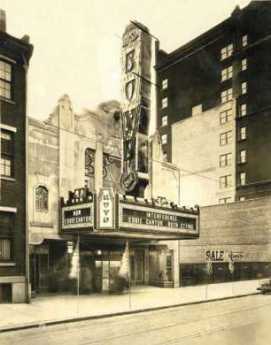
|
| Boyd Theatre |
Howard B. Haas a lawyer, and Shawn Evans an architect, are captains of a team trying to "save" the old Boyd Theatre at 1908 Chestnut Street. Since Clear Channel, the present owner has invested $13million in the property, and the preservationists agree that renovation of the movie palace to all its former glory would cost between $20million and $30million more, it's easy to understand why every other movie palace in central Philadelphia has been demolished. Furthermore, that area of town is having a resurgence of high-rise construction, so one use of the property must be balanced against others.
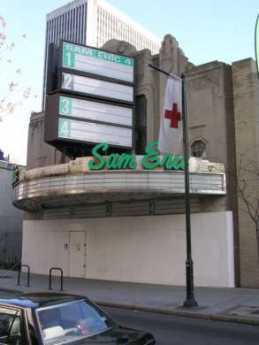
|
| Sam Eric |
The Boyd was built in 1928, just before the stock market crash, and closed in 2002. In fact, it changed its name to SamEric in its dying days, but the public remembers it as the Boyd, one of ten movie palaces in center city. The definition of a "palace" is arbitrary but is generally taken to be a theater with more than a thousand seats, normally with hyperbolic architecture to fit its hyperbolic advertising. Scholars of the matter say the earliest movie houses were constructed in Egyptian style, soon evolving into French Art Deco. Ornate, whatever it's called.
The palace concept developed in the era of silent films, with subtitles. Anyone who has experimented with home movies knows that the silent film sort of lacks something, particularly between reels and at times of breakdown in the projection. That's why brass bands played on the sidewalk outside, pipe organs played during intermissions, and all manner of vaudeville appeared on stage. Sound movies, or talkies, were immediately much more popular when they appeared in 1927, and had less need of the window dressing from other distractions which had grown into a moviehouse tradition which was slow to die.
The movie studios owned the films and soon built theaters to display them. The movie business was quite profitable from the start, so studios had the necessary finance to spread a network of very large theaters across the country quickly. The ability to concentrate hyped-up advertising with immediate display of the product in large captive theaters tended to drive the model of the "palace", which was able to sustain higher ticket prices than trickling a larger number of film copies to myriads of small "mom and pop" local theaters. In very short order, going downtown to see movies became at one time the largest reason for suburbanites to go to the center of town on public transportation, fitting in nicely with the concentration of huge department stores, also located there. Restaurants, bars, bowling alleys, and shops grew up to address the crowds. Furthermore, the economic depression of the 1930s slowed down what was to become a relentless automobile-flight to the suburbs. After the spread of free television at home in 1950, the downtown movie palaces were doomed. The legal profession helped, too. Small suburban theater operators eventually won an antitrust suit against what they described as monopoly power of studio-owned center city palaces, so a host of small sharks in the suburbs started to eat the whales downtown. Furthermore, the sound quality was easier to achieve in a smaller auditorium. To tell the truth, fire hazard was also lessened without the arc-lamps needed to project images across a long distance.
So, a new technology interacting with an old theatrical tradition quickly created the movie industry in its downtown movie palace form; more advancing technology quickly destroyed it, with a little help from economics and politics. Good luck to the friends of this historical epoch, who have a monumental task ahead to work up the public nostalgia and political strength required to overcome a huge economic obstacle of the "highest, best use of the land". In many ways, the most valuable contribution of this movie palace restoration movement is to dramatize in the public mind just how urban centers function. Department stores are gone, going in town to the movies is over. How else are you now going to get the couch potatoes to go downtown voluntarily, and often? Just imagine ten palaces simultaneously filling up with several thousand suburbanites apiece, seven nights a week. Without those additional drawbacks on ample display in Atlantic City and Las Vegas, please.
WWW.Philadelphia-Reflections.com/blog/1190.htm
Venturi's Franklin Museum in Franklin Court
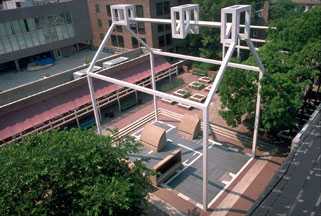
|
| Franklin Court Museum |
When Judge Edwin O. Lewis was seized with the idea of making a national monument out of Colonial Philadelphia, he wanted it big. Forty or so years later, it's big all right, but not big enough to encompass the whole of America's most historic square mile. Government ownership in the form of a cross now extends five blocks north from Washington Square to Franklin Square, and four blocks East from Sixth to Second Streets. Restoration and historic display have spread considerably beyond that cross, however, and the Park Service has created ingenious walkways within the working city in the neighborhood. If you thread your way through these walkways, you can stroll for miles within the world of William Penn and Benjamin Franklin. One such unexpected walkway is now called Franklin Court, which essentially cuts from Market to Chestnut Streets, within the block bounded by 3rd and 4th Streets. Hidden in the center is the reconstructed ghost of Franklin's quite large house, sitting in an interior courtyard bounded by a colonial post office, and a newspaper office once operated by Franklin's grandson. And, along the side of the walkway near Chestnut Street, is a fascinating museum of Franklin's personal life, built by no less than Frank Venturi, and operated by Park Rangers in the polished but low-key manner for which the U.S. Park Service is famous.
For some reason, this jewel of a museum has not received the high-powered publicity it deserves. It's off the main Park premises, as we mentioned, and some of the problem has to be attributed to Venturi. As you walk through, you don't expect a huge museum to be there, and it can look pretty inconspicuous as you walk past because it is mostly underground. Take my word for it, it's worth a visit. There are long descending ramps inside the doors, which can be pretty daunting if you are elderly and tired. But, also inconspicuous, there's an elevator if you look around for it. Venturi didn't seem to like windows very much, which is a problem for some people.
There's a movie theater inside there, playing a long list of fascinating documentaries. There's an ingenious automated display of statuettes which utilize spotlights and revolving stages to present Franklin in Parliament, resisting the Stamp Act, Franklin being his charming self before the French monarchs, and the frail dying Franklin getting the Constitutional Convention to approve the document. There are also a variety of ingenious inventions of Franklin's on display in the original, including bifocal glasses, the first storage battery, a simplified clock, several library devices, the Franklin stove, and so on. In some ways, the highlight is the Armonica.
The Armonica is the musical instrument invented by Franklin, for which both Beethoven and Mozart composed special music to exploit its haunting tone. If you ask the nice Park Ranger, she will be flattered to play you a tune on it.
Quaker Gray Turns Quaker Green
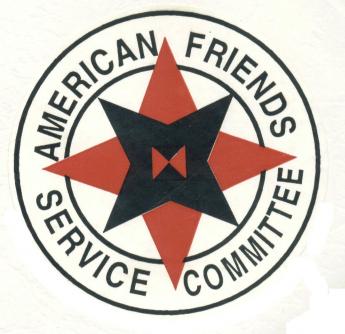
|
| American Friends Service Committee Logo |
Miriam Fisher Schaefer, at one time the Chief Financial Officer of the American Friends Service Committee, had to cope with the economics of renovating the business headquarters complex for various central Quaker organizations. They're housed in a red-brick building complex, naturally, located on North 15th Street right next to the Municipal Services Building of the Philadelphia City Hall complex. The original building within the complex is the Race Street Meetinghouse, funds for which were originally raised by Lucretia Mott. The Quakers needed to expand and renovate their offices, a nine million dollar project. Miriam, a CPA, calculated that the job could be made completely environment-friendly for an extra $3 million. The extra 25% construction cost explains why very few buildings are as energy-efficient as they easily could be. However, in the long run, a "green" building eventually proves to be considerably cheaper. Not only would a green Quaker headquarters be a highly visible "witness" to environmental improvement, but it would also pay for itself in reduced expenses after about eight years. That is, if friends of the environment would provide $3 million in after-tax contributions, they would provide a highly visible example to the world, and reduce the running expenses of the Quaker center by a quarter of a million a year, indefinitely. Effectively, this is a charitable donation with a permanent tax-free investment return of 12%, quite nicely within the Quaker tradition of doing well while doing good.
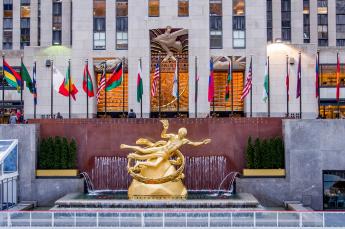
|
| Rockefeller Center |
Energy efficiency isn't one big thing, it is a lot of little things. If you dig a well deep enough, its water will have a temperature of 55 degrees, and only require heating up another 15 degrees to be comfortable in winter, or cooling down thirty degrees to be comfortable in the summer; that's described as a heat pump. Then, if you plant sedum, a hardy desert succulent plant, on the roof it will insulate the building, slow down rainwater runoff, and probably never have to be replaced. Rockefeller Center, you might be interested to learn, has a "green roof" of this sort, which has so far lasted seventy years without replacement. The Race Street Meetinghouse was built in 1854 and has so far had many roof replacements, each of which created a minor financial crisis when the need suddenly arose.
The ecology preservation movement is full of other great ideas for city buildings because buildings --through their heating, ventilating and air conditioning -- contribute more carbon pollution to the atmosphere than cars do. For another example, fifty percent of the contents of landfills originate in dumpsters taking construction trash away from building sites. What mainly stands in the way of more recycling of such trash is the extra expense of sorting out the ingredients. Catching rainwater runoff allows its reuse in toilets, eliminating the need to chlorinate it, meter it, and transport it from the rivers. And so forth; you can expect to hear about this sort of thing with great regularity now that the Quakers have got stirred up. You could save a lot of air conditioning cost by painting your roof white. At first, that would look funny. But do you suppose oddness would bother the Society of Friends for one instant? No, and you can expect them to make it popular, in time. People at first generally hate to look funny, but with the passage of time they grow to like looking intelligent.
A lot of people want to save the planet. So do the Quakers, but they have come to the view that the public is more easily persuaded to save money.
Pennsbury Manor
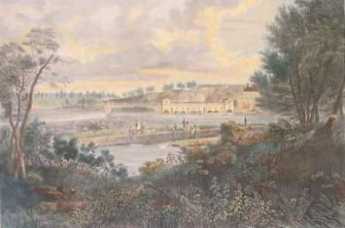
|
| Fairmount |
William Penn once had his pick of the best home sites in three states, because of course he more or less owned all three (states, that is). Aside from Philadelphia townhouses, he first picked Faire Mount, where the Philadelphia Art Museum now stands. For some reason, he gave up that idea and built Pennsbury, his country estate, across the river from what is now Trenton. It's in the crook of a sharp bend in the river but is rather puzzlingly surrounded by what most of us would call swamps. The estate has been elegantly restored and is visited by hosts of visitors, sometimes two thousand in a day. On other days it is deserted, so it's worth telephoning in advance to plan a trip.
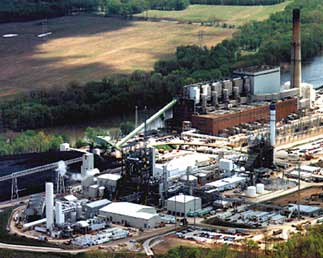
|
| Gasified Garbage |
After World War II, a giant steel plant was placed nearby in Morrisville, thriving on shiploads of iron ore from Labrador, but now closed. Morrisville had a brief flurry of prosperity, now seemingly lost forever. However, as you drive through the area you can see huge recycling and waste disposal plants, and you can tell from the verdant soil heaps that the recycled waste is filling in the swamps. It doesn't take much imagination to foresee swamps turning into lakes surrounded by lawns, on top of which will be many exurban houses. How much of this will be planned communities and how much simply sold off to local developers, surely depends on the decisions of some remote corporate Board of Directors.
However, it's intriguing to imagine the dreams of best-case planners. Radiating from Pennsbury, there are two strips of charming waterfront extending for miles, north to Washingtons Crossing, and West to Bristol. If you arrange for a dozen lakes in the middle of this promontory, surround them with lawns nurtured by recycled waste, you could imagine a resort community, a new city, an upscale exurban paradise, or all three combined. It's sad to think that whether this happens here or on the comparable New Jersey side of the river depends on state taxes. Inevitably, that means that lobbying and corruption will rule the day and the pace of progress.
Meanwhile, take a trip from Washingtons Crossing to Bristol, by way of Pennsbury. It can be done in an hour, plus an extra hour or so to tour Penn's mansion if the school kids aren't there. Add a tour of Bristol to make it a morning, and some tours of the remaining riverbank mansions, to make a day of it.
Wall Art in Philadelphia
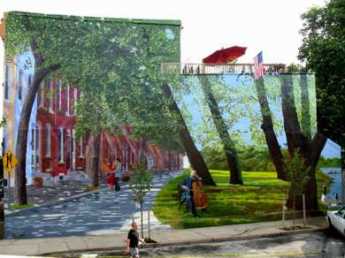
|
| Seasons |
At last count, Mural Arts program of the city government of Philadelphia has sponsored and paid for 2700 large paintings on the walls of buildings around town, and several hundred more have appeared spontaneously. Comparatively few art museums have that many on display, so people are proud of the Philadelphia effort.
This program is now nearly thirty years old, beginning to emerge as a national treasure. Looking back, it is pleasing that it had humble, even deplorable, origins. As American cities lost their industrial focus, many homes in the neighborhood of former factories have been abandoned, getting torn down in random patterns. Industrial cities of the East Coast were tightly packed to save land costs and time commuting to work; the fashion of "row houses" evolved without any space between neighbors sharing a "party" wall. When a row house was torn down, there emerged a scabrous ghost, because the wallpapered interior walls were exposed and looked pretty hideous. It eventually became illegal to leave a scabrous building, leading to elaborate legal conventions about responsibility for the cost of covering exposed surfaces with concrete stucco. During the last half of the Twentieth Century, stucco was generally an improvement.

|
| Graffitti |
Meanwhile, during World War II it became clever for American military to inscribe "Kilroy was here" on unprotected public surfaces at home and abroad as a gesture of American triumphalism. Opinions differ about whether this started originally as an allusion to a certain line of 19th Century romance poetry, or whether there was in fact a John J. Kilroy, inspector of riveting in wartime shipyards, marking riveted materials with his name to enable piecework payment for shipyard tasks. Eventually, this Kilroy joke became a little tiresome, but soon was replaced by stylized decorations using cans of spray paint, until "graffiti" painting, in turn, became a public nuisance. It is true some graffiti artists were quite talented, but the associated vandalism of teenagers added a threatening quality to public defacement of property belonging to others. By implication, an area with graffiti was a home of lawlessness and that implication cast a negative shadow on the city economy. Public opinion demanded something effective be done to stop it.
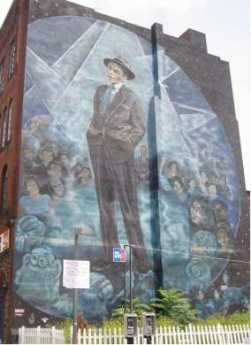
|
| Frank Sintra |
Since graffiti vandalism has declined nationwide in the past twenty years, it is difficult to claim that one public initiative in Philadelphia cleaned it up. But it might be true. Then-Mayor Wilson Goode formed an antigraffiti Network, essentially a think tank for concerned citizens, floundering about for a solution to an appalling problem. Somehow the inspired idea arose that the graffiti artists might be channeled into better directions if given professional art lessons, and working materials. A West-Coast artist named Jane Golden was hired to supervise what has become a multimillion-dollar project, overseen by some sort of guiding hand pushing the whole city into becoming part of a gigantic art project. Guides tell visitors that there are fifty employees involved in publicity and legal work, organizing artists, fundraising, organizing teams of painters at all levels of competence, helping oversee the general appropriateness of what is happening. And at the head of this team is Jane, a tornado of energy.
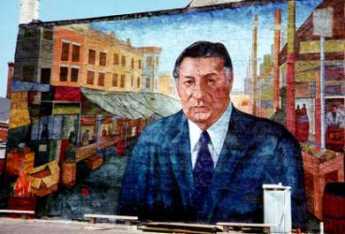
|
| Frank Rizzo |
It costs forty to seventy thousand dollars to produce one of these works, and since they are exposed to the weather, they only last about fifteen years. There are several techniques for transforming a small artwork into a big outdoor copy, some of them tracing back to Michaelangelo. Most of the Philadelphia murals are produced by dividing the original small artwork into squares and transferring numbered squares to the wall, one inch to one foot. As you can see by reviewing some of the websites devoted to the topic, a piece of art which is quite appealing can sometimes change into a drab mess when its size is blown up to three-story height. The problems of lighting such work are quite different from the lighting of a gallery painting. The surface is seldom smooth, so the bumps and grooves of the underlying scabrous "canvas" can destroy, or sometimes dramatically enhance, a salon painting. If you get too close, you can't see all of it, and that may be a problem. It's probably not entirely predictable what will come out in the final product.
There are inevitably political problems as well. The best examples are the several paintings of former Mayor Frank Rizzo, who is a hero to the Italian neighborhoods where they stand, but provoke riotous feelings in near-by black districts. Luck alone has confined the antagonisms to graffiti on the murals, viewed by some groups as enhancements on what begins as graffiti. No wonder the committees assigned to approving locations can take a long time to come to a decision.
There's another problem, which seems to be embedded in the situation. In the central city skyscraper district, you don't have scabrous buildings. Nor can mural art be placed in the historic square mile. Just a few blocks in either direction from central city there are plenty of demolitions and scabrous walls, but, close to downtown, these are areas of gentrification and urban renewal. It doesn't make sense to spend fifty thousand dollars to paint a wall which will be demolished in two or three years. The net effect is that the city may have three thousand paintings all right, but only fifty at most are within a tourist ride of Independence Visitors Center. If half of these fifty are concerned with celebrating local heroes unfamiliar to tourists, there can be disappointment which would disappear if a selection of fifty outstanding products could be culled from three thousand -- and grouped together for exhibition.
A solution to these issues will surely emerge with time, but it will evolve, not be envisioned.
Unexpected Benefits of a Lurid Past
 |
| Map of Barnegat Bay |
Centuries came and centuries went, while a Quaker shipyard went on about its business along the shore of Barnegat Bay. Next door there was a notable roadhouse after the second World War, rumored to have formerly been a secret speakeasy during the days of Prohibition. In time, the only occupant of the roadhouse was a wealthy widow, who mostly minded her own business and grew to be an affable neighbor to the Quakers next door. As rowdy days of Prohibition faded into the background of decades past, the old lady felt free to recall some of the less tawdry features of her past, to the Quakers who in turn felt free to chuckle about them. Ancient history, perhaps a little varnished and polished up. It was, however, a little disquieting to hear her say that the liquor for the speakeasy was often supplied by sailors from the Coast Guard, who routinely diverted 20% of the cargo of rum Runners they had captured, into commercial channels. Exciting times, those were.
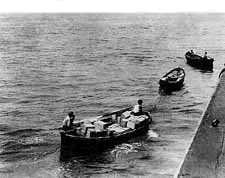 |
| The Coast Guard out looking for Rum Runners |
One day when the widow was ninety-six years old, the lights of her house stayed on, without other signs of activity. The neighbor eventually walked over to the back door and looked through the window, where it could be seen that the old lady was lying on the floor, rather motionless. He might have called the police, or broken into the house, but there was another option.
He went down to the basement, entering a rather dusty but quite elaborate barroom. Following old directions, he walked to a closet and climbed up a stepladder leading into another closet on the floor above. Stepping out, he found the lady was still breathing, called her relatives, and watched her be taken off to a nursing home to end her days. No one seemed to ask very many questions.
Sacred Places at Risk
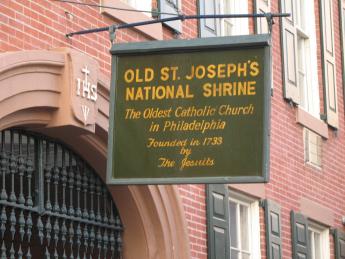
|
| Old St. Joe's |
When William Penn invited all religions to enjoy the freedom of Pennsylvania, he created a home for the first churches in America of many existing religions, and furthermore the founding mother churches for many new religions. Regardless of the local congregation, there is obviously a strong wish to preserve the oldest churches of the Presbyterian, Methodist, United Brethren, African Methodist Episcopal, Baptist, Mennonite, and many other denominations. While the founding church of Roman Catholicism was obviously not in Philadelphia, St. Josephs at 3rd and Willing was for many decades the only place in the American colonies where the Catholic Mass could be openly performed. The towering genius of William Penn lay in the combination of an almost saintly wish to spread religious toleration, combined with what must have been a sure recognition that the motive of Charles II in giving him the land, was to get rid of all those dissenters from England.
Philadelphia now has a thousand church structures within the city limits, and more than a thousand in the suburbs. However, many church buildings find themselves stranded by the migration of local ethnic groups to other locations, and a decision must be made whether to demolish a relic or sell it to a new population who have moved into the old neighborhood with a new religion. There is still greater discomfort with selling an old church to a commercial enterprise, but even that happens. The resulting bewilderment and dissension among the surviving parishioners is easy to imagine as they face these choices, or fail to face them, and it is readily imagined that the establishment in 1989 of Partners for Sacred Places filled a very important need.
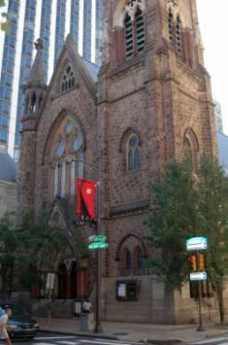
|
| First Presbyterian Church |
The Executive Director, Robert Jaeger, recently described to the Right Angle Club how the Partners operate. First of all, the Constitutional separation of church and state makes it difficult to seek funding or even advice from the Federal government. Pennsylvania has been less hesitant than most states in this regard, but even here the issue of fund-raising is a central issue. One only has to look at the Aztec and Mayan religious sites in Mexico to grasp that there are circumstances when the parishioners of a religion may have completely died out, but their monuments justify state assistance. Private, nondenominational philanthropy seems the easiest route for a society to take, in avoiding the obvious political and legal entanglements of seeming to assist one denomination more than others.
And then there are architectural issues;, can the building be saved at a reasonable cost, is it truly a unique or outstanding piece of art, can a reconstruction go ahead in an incremental way, are the necessary stone or other materials any longer obtainable, do the workman skills exist? In addition to these issues which are commonly presented to a congregation, there are issues they probably have never considered. As congregants move from center-city to the suburbs, they become commuters to church, largely out of touch with the local community and its activities. A survey conducted by the Partners suggests that 81% of the activity which takes place in church buildings on weekdays is conducted by and for non-members of the church; if the two groups lose touch with each other, opportunities are missed, and eventually there may be unnecessary friction. On the other hand, those non-religious activities probably escape the legal prohibitions against government assistance, and may suit themselves as vehicles for indirect government support. The approach has so much promise that Partners for Sacred Places has devised a computer program on their website which provides a way for congregations to assess their assets, and their problems. In fact, the organization conducts extensive training programs for church preservation, and has been forced by the size of the demand to exclude churches that are clearly failing beyond reasonable hope of recovery by their church membership.
The Partnership was originally founded by consolidation of the New York and Philadelphia organizations, to make a stronger national effort. But now things are going the other way. New chapters are springing up in Texas and California. Partners for Sacred Places is obviously proving to be a good idea, effectively managed.
WWW.Philadelphia-Reflections.com/blog/1269.htm
The University Museum: Frozen in Concrete
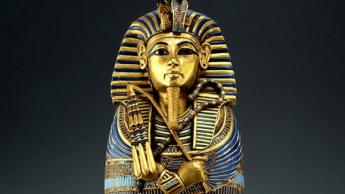
|
| King Tut |
Recently, a charming archeology scholar from the University of Pennsylvania, Leslie Ann Warden, entertained the Right Angle Club with the interesting history of King Tut. Interest in this subject is currently heightened by a traveling exhibit of the tomb relics currently on elegant display at the Franklin Institute. However, Philadelphia also has a permanent exhibition of Egyptian artefacts lodged in the University Museum. Since this museum is the second largest archaeology museum in the world, after the British Museum, that makes it the largest in America. An interesting sidelight is that Ms. Warden spoke in the grill room of the Racquet Club, which was the first effort by William Mercer to use "Mercer" tiles in a building. Mercer at that time was the curator of the University Museum. We learned from Ms. Warden that King Tutankhamen was unknown before his tomb was discovered, all records of this part of the Egyptian dynasty having been lost or deliberately obliterated by successors. Therefore, the discovery of these magnificent art objects started a massive expansion of scholarship about the entire Third Millenium.
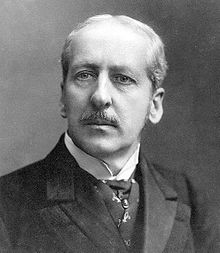
|
| William Pepper |
The establishment of the University Museum around 1890 was apparently mostly due to the enthusiasm of William Pepper, then Provost of the University of Pennsylvania. What seems to have got Pepper going was an expedition to Iraq, the place where civilization began, in Mesopotamia. The relics brought back from this celebrated effort needed a home, and Pepper decided it had to be here. One famous philanthropist after another, often in the role of Chairman of the Board of Trustees, carried on the tradition after Pepper's premature death. Some of them have their names on buildings, some declined. To a notable degree, the feeling of special possession was exemplified by Alexander Stirling Calder, who turned the statues in the garden to face inward rather than out toward the street. Asked whether a mistake had been made, he is said to have replied that due to the Museum's withdrawn character, it was more appropriate for the world to face the Museum. No more icily accurate comment has ever been made about the University's relation to its city neighbors.
The real knock about the Museum is that too much has been crowded into too little real estate, and the fault lies with the automobile. After the University outgrew its space at 9th and Market around 1870, moving then to West Philadelphia, the architects and the donors originally envisioned a grand boulevard of culture stretching from the South Street bridge many blocks westward. The Museum, Franklin Field, Irvine Auditorium, The University Hospital were to be the start of an imposing array of culture. Unfortunately, that was a horse-drawn conception, soon to be overwhelmed by the worst traffic jam in the city. The Schuylkill Expressway was the final blow, setting huge auto-oriented structures in place where their easy removal became difficult to imagine. The 1929 stock crash, followed by confiscatory income and estate tax rates, merely emphasized the plain fact that restoring the grand vision was beyond the ordinary aspirations of even massive private wealth. Transforming the imposing plazas of the University Museum into parking garages was probably a result of excessive despair, but if you have ever tried to find a place to park in that region you can somewhat sympathize with the small-mindedness which prompted it. Bringing back this region is going to require immense vision and resources, neither of which is exactly thrusting itself forward at present. So, unfortunately, one of the central cultural jewels of the City is buried in the midst of an impenetrable thicket of concrete and speeding automobiles, too big to move, too small to burst its bonds.
It's well worth a lot of anybody's time, and many visits. If you can find a way to get there.
Beyond Most of Us
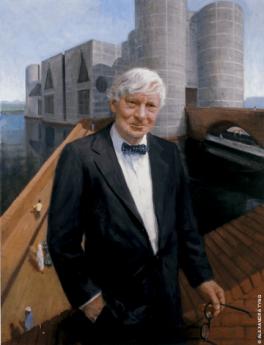
|
| Louis I. Kahn |
The Athenaeum is slowly migrating into a national historical museum of American architecture. In this spirit, it recently presented a lecture by Carter Wiseman of Yale on the subject of Louis I. Kahn to an overflow audience. Professor Wiseman drew his remarks from his recent book about Kahn, called Beyond Time and Style.
Many giants of Philadelphia architecture, like Strickland and Walter, are known to us for the memorable public buildings they designed, but Kahn and Venturi are known for their scientific contributions to the theory of architecture. Their reputations were consequently made among architectural scholars, and then passed on to the public in the form of praise that is a little hard for laymen to understand. For example, Wiseman begins his course on Kahn by telling the students they probably will not understand Kahn at the beginning of the course, but all will revere him by the end of it. The rest of us, of course, have not attended the lectures, and a reciprocal effect probably has something to do with Kahn going to his grave, deeply in debt. No doubt the additional fact that he had three families with three women simultaneously, somewhat strained his cash flow as well.
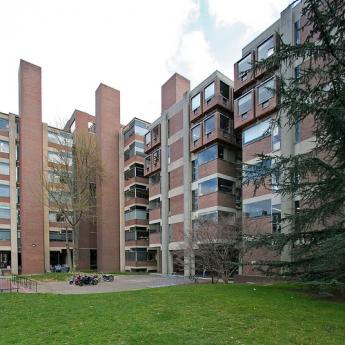
|
| Richards laboratory of the University of Pennsylvania |
Kahn encountered the architectural field toward the end of the period of Modernism, which he referred to as "machines to live in". Rather than overturn the whole idea of Modernism, he softened its harshness through ingenious use of interior lighting, and the use of rough rather than smooth shiny materials. His teaching was that closets, elevator shafts, corridors and the like were "servant" spaces, to be hidden and subordinated to "served" spaces, like reception areas. The overall effect was a deceptive simplicity, often regarded by the public as simple boxes when the underlying design was anything but simple. For some reason, the concepts of rough surfaces and subordinated spaces was particularly effective in India and Pakistan. It was least popular in his two famous American laboratory buildings, the Richards laboratory of the University of Pennsylvania, and the Salk Institute in La Jolla, California. Both of these laboratories were widely praised by architects, and resoundingly hated by the chemists who used them, because chemists are particularly fond of closets. He does have one group of particular enthusiasts among those who own and inhabit the tall glass office buildings which became so popular after the Seagram's tower on Park Avenue in New York. Washing all that glass is a problem and surfaces which don't look dirty so soon, gain advantage.
Professor Wiseman spared his audience the story of Kahn's death, presumably because it is so well known. He died in the washroom of Penn Station in New York, and his body lay unidentified in the morgue for three days. It is supposed that someone stole his wallet with identification papers, because there couldn't have been much else in it to steal.
Germantown Avenue, One End to the Other

|
| Germantown Map |
Chestnut Hill really is a big hill poking up in the middle of Philadelphia, and Germantown Avenue follows an old Indian trail from the Delaware River right up to that hill. The waterfront area of the city has been built and rebuilt to the point where it's now a little hard to say just where Germantown Avenue begins. From a map viewpoint, you might look for a four-way intersection of Frankford Avenue, Delaware Avenue, and Germantown Avenue, underneath the elevated interstate highway of I-95. The present state of demolition and rubble heaps suggests that a Casino might be built there sometime soon, politics and the Mafia permitting.
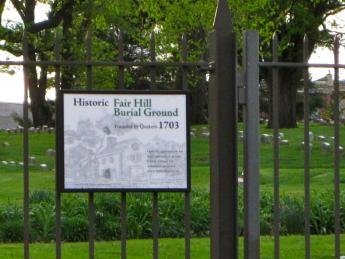
|
| Fair Hill Cemetery |
Although Germantown Avenue has wandered northwestward from this uncertain beginning for over 300 years, up to the rising slope of the town toward Broad Street, it is now rather difficult to make out anything but industrial slum along its path which could be called historic. There is hardly any structure standing which has a colonial shape, and no Flemish bond brickwork is seen in the tumble-down buildings. When with the relief you finally approach Temple University Medical Center at Broad Street, the Fair Hill cemetery does show some effort at preservation, and a sign says that Lucretia Mott is buried there. But that's about all you could photograph without provoking suspicious stares. Here's the first of four segments of Germantown Ave., and it's a pretty sorry sight.
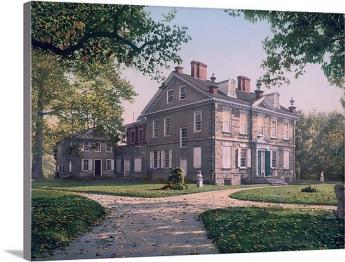
|
| Chew Mansion |
Crossing Broad Street, the busy intersection suggests 19th Century prosperity in its past, and on the west side of Broad, you can start to see signs of historic houses, either in colonial brickwork or grey fieldstone. The road gets steeper as you go west past Mt. Airy, where it almost brings tears to the eyes to see brave remnants of another time. George Washington lived here for a while, and the Wisters, Allens, and Chews; Grumblethorp and Wyck. The huge stone pile of the Chew Mansion glares at the imposing Upsala mansion, where British and Americans lobbed artillery at each other during the Battle of Germantown. Benjamin Chew the Chief Justice built this house as a summer retreat, to get away from Yellow Fever and such, and started the first migration to the leafy suburbs. His main house was on 3rd Street in Society Hill, next to the Powels and where George Washington stayed. At the peak of the hill in Chestnut Hill, a suburb within the city. Germantown Avenue rather abruptly goes from the relics of Germantown to the charming elegance of Chestnut Hill, but during a recession, it frays a little even there. At the very top is the mansion of the Stroud family, now in the hands of non-profits; across the road in Chestnut Hill Hospital, once the domain of the Vaux family. Then down the hill to Whitemarsh, where the British once tried to make a surprise raid on Washington's army. As you cross the county line into Montgomery County, it's conventional to start calling the Avenue, Germantown Pike. Germantown Pike was in fact created in 1687 by the Provincial government as a cart road from Philadelphia to Plymouth Meeting. Farmers used to pay off their taxes by laboring on the dirt road, at 80 cents a day. Germantown Pike, Ridge Pike, Skippack Pike, Lancaster Pike, and others are a local reminder that Pennsylvania was always the center of turnpike popularity; that's how we thought roads should be paid for. The present governor (Rendell) hopes to sell off some better-paying turnpikes to the Arabs and Orientals, possibly imitating Rockefeller Center by buying them back and reselling them several times by outguessing the business cycle. Parenthetically, the Finance Director of another state at a cocktail party recently snarled that the purpose of privatizing state infrastructure was not to raise revenue, but to provide collateral for more state borrowing. He wasn't at a tea party, but he may soon find himself there.
From a modern perspective, the third segment of the Germantown road runs from Chestnut Hill to Plymouth Meeting, with lovely farmhouses getting swallowed up by intervening, possibly intrusive, exurbia. The township of Plymouth Meeting is a hundred years older than Montgomery County, having been built to be near a natural ford in the Schuylkill River. Norristown, a little downstream, is the first fordable point on the Schuylkill, with Pottstown making a third. Plymouth's colonial character survived a period of industrialization based on local iron and limestone, and has established several prominent schools for the surrounding area. But the construction of a substantial highway bridge attracted a large and busy shopping center. The shopping center looks as though it will eradicate the quaint historical atmosphere more effectively than industrialization ever could.
The fourth and final segment of Germantown Pike starts at the Schuylkill and goes over rolling countryside to its final destination at Perkiomenville, where it joins Ridge Pike at the edge of the Perkiomen Creek. That's an Indian name, originally Pahkehoma. Perkiomenville Tavern claims to be the oldest inn in America, although that honor is contested by another one along the Hudson River near Hyde Park. The WPA during the Great Depression constructed a large park along the Perkiomen Creek for several thousand acres of camping and fishing, so Perkiomenville has several large roadhouse restaurants and antique auctions for bored wives of the fishermen. In the V where Ridge Pike and Germantown Pike come together, a dozen or more colonial houses are tucked away in a town called Evansburg. This formerly Mennonite terminus of Germantown Pike obviously still has a lot of charm potential, and its local inhabitants are very proud of the place. But it's easy to zip past without noticing the area, which includes an 8-arch stone bridge, said shyly to be the oldest in the country. It's hard to know whether you wish more people would visit and appreciate; or whether you are happy that obscurity might permit it to survive another century or so.
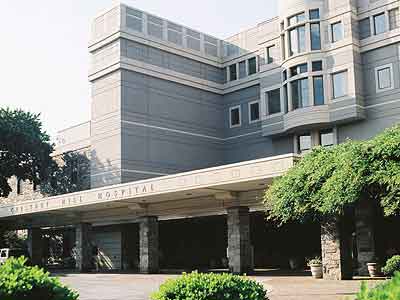
|
| Chestnut Hill Hospital |
The name change of the Germantown road from Avenue to Pike is probably not precisely where the turnpike began, but it is now notable for some pretty imposing mansions, standing between the humble and even somewhat dangerous slums along Delaware, and the charmingly humble but well-preserved Mennonite villages, at the other end. It is arresting to consider the two ends, whose houses were built at the same time; only the Mennonites endure. Somewhere just beyond the Chestnut Hill mansions is an invisible line. West of that point, when you say you are going to town, you mean Pottstown. When you say you are going to the City, you mean Reading. And as for Philadelphia, well, you went there once or twice when you were young.
Trapped in a Casino
Everyone who reads a detective novel or sees a James Bond movie is familiar with secret passages and hidden protection devices that suddenly trap the unwary. You aren't supposed to know about these things, but in real life, lots of people have had to know the secret, because it takes builders, architects and workmen to create it. Ancient Chinese and Egyptian emperors may have buried workmen alive to preserve the secret of secret passages, but nowadays that sort of thing is discouraged.
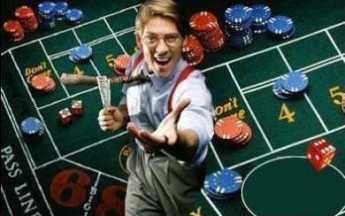
|
| Gambling |
Since nowadays gambling casinos are bought and sold like a bottle of milk, some of the people who just have to be told the secrets of casinos are real estate appraisers; from one of them, the following tidbit derives. Casinos try not to have any windows, so the serious slot machine players won't notice the passage of time, and maybe gamble all night when so inclined. It is, therefore, no surprise the ceilings and walls are usually mirrored, to make these windowless caverns seem gay and cheerful. The casino operator doesn't want anyone to go home for any reason other than running out of money, and depends heavily on the wisdom of Adam Smith, who once said, "The more you gamble, the more certain you are to lose."
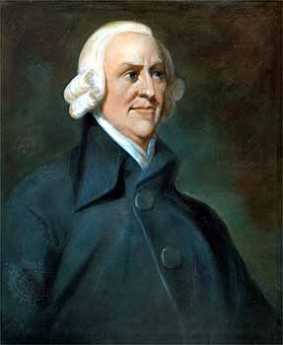
|
| Adam Smith |
Unfortunately, these palaces of pleasure attract a fair number of cheaters, who attempt to win by memorizing the cards that have been played and changing their bets with the changing odds of what remains unplayed in the deck ("card counters"). Others are more mechanically talented and drill holes into the works of slot machines with battery-driven portable drills, for later accomplices to insert metal rods into vital wheels and whatnot on the inside. And so on. So, the mirrors on the ceiling are one-way mirrors, with people observing what goes on below, and cameras recording every action of everybody. In this modern age, some casinos can bring up videos of what happened on a particular machine at a given time, several years ago. This elaborate recorded surveillance can be used to unravel the activities of visiting crooks, who quite often do their work over a period of some time, coming back to the same machine for another step in their fiendish schemes. Now, there's another consideration at play here. The casino operator does not want a commotion on the gambling floor when some crook is accosted, because that tends to divert dozens of gambling addicts from their incessant gambling in order to watch the excitement. This would definitely be a violation of Adam Smith's law of gambling, and hence would subtract from the value of stopping the crook who was caught. No good.

|
| Casino Video Surveillance |
So, the merry men up above on the other side of the mirrored ceiling will merely watch and record the activity of the miscreant below, apparently letting him get away with it. But sooner or later the crook has stolen enough or has to go the bathroom, or for some other reason leaves the casino floor. Bang, the door behind him closes and locks, and the door on the other side of the trap is also locked. Thus, without any fuss or muss (maybe) the crook is observed by witnesses, recorded on camera, and tucked away in a security chamber until such time as the security guards can arrive to advise him of the management's disapproval of his behavior. Just exactly what does happen when one of these people is caught is not something they need to tell a real estate appraiser, so, unfortunately, I have to leave it to your imagination.
Roebling
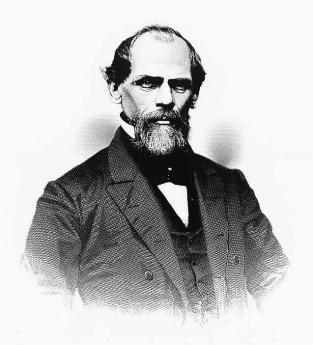
|
| John Roebling |
The common image of John A. Roebling comes across a little hazy about details, but seems to consist of going down with the Titanic at the age of 31, with being born in Prussia in 1837, with getting the "bends" while building the Brooklyn Bridge, and first sighting General Robert E. Lee's invading army from a balloon, then dragging a cannon up Little Round Top. The obvious inconsistencies in this image do not prove they are fictitious, they prove that Roebling was several people. Mostly this composite centers on Johann Augustus Roebling and his three sons, but spreads out to a large and highly talented family. Roebling achievements are not those of a bee, but of a beehive.
Johann was a younger child in a large Prussian family living a hundred miles south of Berlin. The region had been ruled under Napoleon for seven years, creating much of the centralized governance we now call "Prussian". Following centralized orders, its school had been designated to be an expert in science and engineering. Johann was particularly good at math and was singled out for intensive training in math and science, later sent to Berlin for advanced training in engineering. While there, he fell under the influence of the philosopher Hegel, who proclaimed that anyone could be anything he wanted to be, but opportunities were particularly good in America. Since Berlin went on to become the world center of electrical engineering, the world would probably have heard more of Johann Augustus Roebling even if he had remained at home; but he was going to do big things in the steel industry, so off he went to Pittsburgh. Things went rather well for him there, especially after he substituted wire rope for hemp rope in pulling canal boats over the Allegheny mountains. From that point on, John A. Roebling concentrated on perfecting and manufacturing wire cable, on which he held several key patents, and moved his business to the head of the Delaware Bay at Trenton, strategic in sales location between New York and Philadelphia.
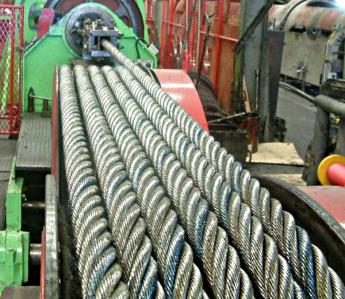
|
| Wire Rope Factory |
Although his company would eventually build an open hearth steel mill, the Roebling enterprise always retained a central focus on steel cables made of steel wires bound together for flexibility and strength. The plant next door in Trenton, the Cooper, Hewitt Co., created the steel I-beam and thus was central in the construction of skyscrapers. Roebling supplied steel cable for elevators, without which skyscrapers would have been limited to six or eight stories. The wires within the cables start from what we can now visualize as the child's toy Slinkies (also a Roebling product, by the way). The trick to making such coils into cables was to find a way to straighten them out, which Roebling devised and patented, using a wheel arrangement to twist the wire as it unwound. Later, the wires were galvanized and compressed together. If the cables were used to carry electricity, it was necessary to cover the cable with rubber insulation as part of the manufacturing process. Eventually, over fifty different processes needed to be perfected and employed to create large quantities of non-brittle uniform cable product at low prices. Apparently, the central problem in manufacture was to smooth off burrs in the wire and meanwhile keep the assembly scrupulously clean. Roebling learned how to overcome all of the many problems in this deceptively simple-looking process, which eventually meant that the main problems remaining were in designing factories rather than designing cables. During the taming of the west, he produced barbed wire; during the rise of mass agriculture, he devised ways to use wire binders for sheaves of wheat. During the rise of electricity, he provided insulated wire and cable, first for the telegraph and then for the telephone. He even recognized the best business model; make huge profits during the first few years of a new product, then cut prices. By far the most famous product of the Roebling company was the suspension cable in suspension bridges.
Indeed, many people associate the Roebling name with bridge building, even though wire cable was and continued to be the central activity of the company. It was characteristic of the Roebling energy and engineering skill that he saw that if he wanted to sell cable, he had to show others how to use it, and he essentially took over the design and construction oversight of the twelve largest suspension bridges in the country. Unfortunately, his foot was crushed in a construction accident and when he died, the building of the Brooklyn Bridge had to be turned over to his son Washington Roebling. Washington, in turn, became badly crippled by caisson disease, the "bends", and hands-on oversight was conducted in large part by his wife, following meticulous instructions by her partially blinded husband.

|
| Brooklyn Bridge |
The work of building and designing factories for the company fell to Washington's brother Charles, and since the company was constantly changing focus in order to exploit new product lines, it was a prodigious task, always under time pressure. What's more, the main factories burned to the ground at least six different times, probably from arson in at least several cases. The Roeblings all worked like dogs for endless hours, well into old age. There was comparatively little ostentatious display of wealth, and when US Steel offered to buy them out, they declined an offer equivalent to one-fifth of the value of US Steel itself. That was during an economic downturn; Roebling was probably worth half of the value of US Steel. Andrew Carnegie might sell out, but not the Roeblings.
George Washington once reversed the Revolutionary War just up the street from the Roebling plant, and John Roebling's son was named after him. Roebling was a patriot and an active Republican. But there was enough Prussian in him to prefer German workmen and to hate unions. When the company grew large, he was forced to hire immigrants from what he called the Hapsburg Empire, although he never completely trusted them. Judging from his writing, he regarded unions as merely trying to take away control of the company without investing in it, certainly without earning it. Surviving numerous fires, recessions, and wartime demands for expansion without profit, it was plainly obvious that when times were tough and money had to be raised, there was no one except the owner to produce it. It is not difficult to imagine the hatred in the minds of union leaders, confronting a family that regarded lowered wages during the depression as normal and necessary. In the Roebling view, standing up to worker protests in such circumstances was simply a test of character, something an owner simply had to find the courage to do.
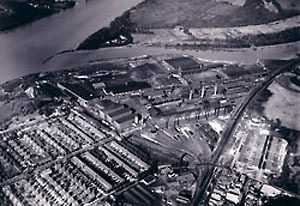
|
| Roebling Village 1930 |
When it became necessary to build a huge new plant at some distance downriver, the Roeblings had to contend with a shortage of labor in a region without houses. So they built a company town which they declined to name Roebling but the railroad named the stop Roebling anyway. Using engineering skill that had made Roebling the world leader, the homes were inexpensive but elegant for the time and even today. The company had to build stores, streets, schools, and everything else a town needed. The new headaches of this project took time and attention away from the central business of making steel cables, and Washington Roebling once wrote it was enough to drive you crazy.
So, guess what, the unions felt they had to take the lead in complaining and forcing the Roeblings to make changes. Guess what happened next; the Roeblings just sold it and walked away.
REFERENCES
| The Company Town: The Industrial Edens and Satanic Mills That Shaped the American Economy, Hardy Green ASIN: B003XKN7MW | Amazon |
Frank Furness,(3) Rush's Lancer
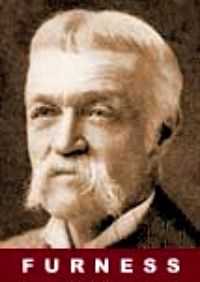
|
| Frank Furness |
Lunch at the Franklin Inn Club was recently enlivened by David Wieck, who not only does the sort of thing you get an MBA degree for but is also a noted authority on the Civil War. His topic was the wartime exploits of Frank Furness, whose name is often mispronounced but whose thumbprints are all over the architecture of 19th Century Philadelphia. Take a look at the Pennsylvania Academy of Fine Arts, Boathouse #13 of the Schuylkill Navy, the Fisher Building of the University of Pennsylvania, and many other surviving structures of the 600 buildings his firm built in 40 years. One of them is the Unitarian Church at 22nd and Chestnut, where his grandfather had been the fire-brand abolitionist minister.
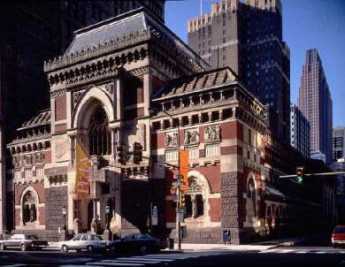
|
| PennsylvaniaAcademy of Fine Arts |
The Civil War seems to have transformed Frank Furness in a number of ways. He had been sort of in the shadow of his older brother Horace, a big man on the campus of Princeton, later the founder of the Shakspere Society, and the Variorum Shakespeare. Frank was quiet, and good at drawing. However, at age 22 he was socially eligible to join Rush's Lancers, the 6th Pennsylvania Cavalry, which contained among other socialites the great-grandson of Robert Morris, and a member of the Biddle Family who put up the money to equip the troop with 7-shot repeating rifles. Cavalry units like this were a vital weapon in the Civil War because they needed young well-equipped expert horsemen with a strong sense of group loyalty. Rifles were considered too expensive for infantry, who were equipped with muskets that took several minutes to reload, and were unwieldy because they were only accurate if they were very long. When bands of daredevils on horseback suddenly attacked with seven-shot repeating rifles, they could be devastating against massed infantry. A flavor of their bravado emerges from their rescue of General Custer's men from a tight spot, later known in the annals of the troop as "Custer's first last stand."
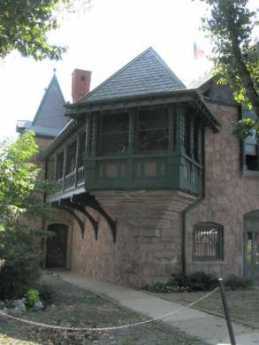
|
| The Undine Barge Club Boathouse #13 of the Schuylkill Navy |
There are two famous stories of the exploits of Frank Furness, first as a second Lieutenant and later as a Captain at Cold Harbor two years later. In the first episode, a wounded Confederate soldier lay on the no man's land of forces only a hundred yards apart. His screams were so heart-rending that Furness ran out to him and put a handkerchief tourniquet around his bleeding thigh. Because the fallen man was a Confederate soldier, the Confederates held their fire and later cheered the Union cavalryman for his kindness. The wounded man called out "
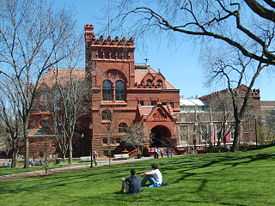
|
| The Fisher Building of the University of Pennsylvania |
In the second episode, the cavalry had spread out too much, leaving some isolated parties trapped and out of ammunition. Furness lifted a hundred-pound box of ammunition to his head and ran through the gunfire with it to the trapped men. For this, he later received the Congressional Medal of Honor. Somehow all of the public attention he received in the war transformed Furness from a younger brother who was good at drawing into a dynamo of energy, much in the model of what law firms call a "rainmaker". He traveled to the Yellowstone area of Wyoming at least six times, bringing back various trophies. He was known to get people's attention by using his service revolver to take pot shots at a stuffed moose head in his office.
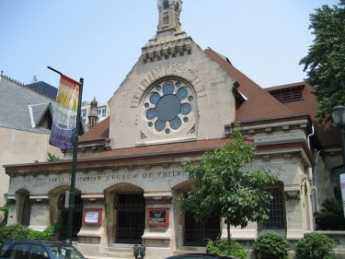
|
| First Unitarian Church 22nd Chestnut Philadelphia |
His final publicity venture was to advertise, forty years later, in Southern newspapers for the whereabouts of the Confederate soldier whose life he had saved. Eventually, a man named Hodge who had later been a sheriff in Virginia, stepped forward to renew his blessings and thanks. Hodge was brought to Philadelphia for a celebrated 6th Cavalry reunion, and a picture of the two former enemies was spread in the newspapers. It was a little embarrassing that Furness and Hodge found they had very little to say to each other for a five-day visit, but Hodge eventually proved able to be one-up in the situation. He outlived Furness by five years.
Although the style of Furness confections seemed and seems a little strange to everyone except Victorian Philadelphians, he did leave a major stamp on American architecture. His most noted student was Louis B. Sullivan, who put an entirely different sort of stamp on Chicago. And Sullivan's best-known student was Frank Lloyd Wright who created a modernist image of architecture for the West. The buildings of these three don't look at all alike, but their rainmaker personalities are all essentially the same.
Frank Furness (1):PAFA
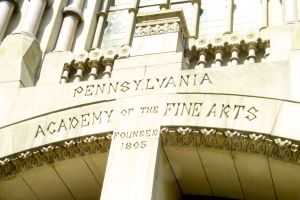
|
| Pennsylvania Academy of the Fine Arts |
The Pennsylvania Academy of Fine Art is notable for its place in Art history, for its faculty over the centuries, and for its influential student graduates. It is therefore not to slight the institution's remarkable place in the world of art if we pause to notice that the building itself, the place that houses all this, is itself an outstanding work of art. Whenever mention is made of Frank Furness, its colorful and influential architect, the first stop on the list is the building he built to house a school and display its glories. Perhaps the best way to illustrate the achievement is to compare it with the Barnes Museum, which also was built to house a school. It also has an outstanding permanent collection, perhaps a greater one than PAFA. But the Barnes building scarcely gets a mention and is about to be abandoned for a preferable location. The Furness building, however, is a massive pile of solid rock, immovable throughout massive changes in its neighborhood. To move that building out to the Parkway has never even been suggested. You can move if you like; we were here first.
The exhibition rooms are interesting, even clever, but the hand and mind of the architect are best seen in the school, the Academy. Seldom seen by the public, the entrance to the school is underneath the front staircase which sweeps the public visitors off to see the exhibition. Up to the stairs, admire the carved walls, the massive supports and the iron railings and out into rooms with scarlet and gold walls, and a blue ceiling with stars. When it leaves, the public sweeps back down the inside stairs and out the tunnel-like entrance, then down the outside stairs. Where was the school?
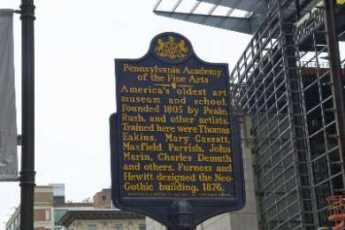
|
| PAFA Marker |
It's underneath the exhibition area, reached by a door under the stairs, unnoticed unless you ask for it. There you will find a darkened lecture hall and corridors lined with plaster casts for teaching purposes. But an artist's studio must have diffused northern light, and lots of it; the problem for the architect was to provide a huge slanted northern skylight over a basement. This trick was accomplished by pushing the walls of the first floor out to the street and installing a slanted skylight in the "ceiling" of the overhang. When the overall effect is that of a fortress meant to defend against a barbarian invader, built with massive walls and roof -- hiding a glass skylight is quite an achievement. Furness was a showman; it was not beyond him to place an architectural tour de force right in front of generations of students looking for something to portray.
We are told the building was five years in construction, designed and re-designed as it rose. The resulting effect is achieved by building around its interior as it evolves from bottom to top. Quite a difference from buildings laid out in advance, forcing the interior contents to conform to the initial design without regard to cramming down its contents. There is an overall design at work here; it's evocative of a Norman church with side extensions, but you have to look for that rather than having the architect thrust it in your face.
Frank Furness (2) Rittenhouse Square
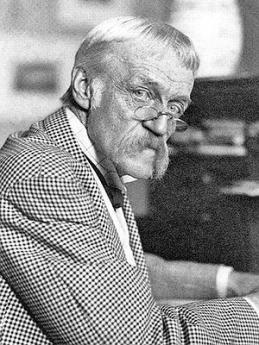
|
| Frank Furness |
George Washington had two hundred slaves, Benjamin Chew had five hundred. It wasn't lack of wealth that restrained the size and opulence of their mansions, particularly the ones in the center of town. The lack of central heating forced even the richest of them to keep the windows small, the fireplaces drafty and numerous, the ceilings low. Small windows in a big room make it a dark cave, even with a lot of candles; a low ceiling in a big room is oppressive. Sweeping staircases are grand, but a lot of heat goes up that opening; sweeping staircases are for Natchez and Atlanta perhaps, but up north around here they aren't terribly practical. Building a stone house near a quarry has always been practical, but if there is insufficient local stone, you need railroads to transport the rocks.
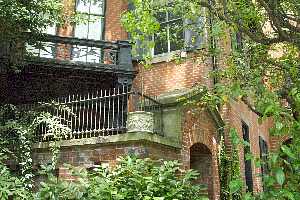
|
| Early Victorian |
So to a certain extent, the advent of central heating, large plates of window glass, and transportation for heavy stone and girders amounted to emancipation from the cramped little houses of the Founding Fathers. Lead paint, now much scorned for its effect on premature babies, emancipated the color schemes of the Victorian house. Many of the war profiteers of the Civil War were indeed tasteless parvenu, but it is a narrow view of the Victorian middle class to assume that the overdone features of Victorian architecture can be mainly attributed to the personalities of the Robber Barons. This is not the first nor the only generation to believe that a big house is better than a small one. The architects were at work here, too. It was their job to learn about new building techniques and materials, and they were richly rewarded for showing the public what was newly possible. Frank Furness was as flamboyant as they come, a winner of the Congressional Medal of Honor for heroism, a man who wore a revolver in Victorian Philadelphia and took pot-shots at stuffed animal heads in his office. He affected the manners of a genius, and his later decline in public esteem was not so much disillusion with him as with the cost of heating (later air-conditioning), cleaning, and maintenance which soon exceeded provable utility. The simultaneous arrival of the 1929 financial crash and inexpensive automobile commuting to the suburbs stranded square miles of these overbuilt structures. It was the custom to build a big house on Locust, Spruce or Pine Streets, with a small servant's house on the back alley. During the Depression of the 1930s, there were many families who sold the big house and moved into the small one. Real estate values declined faster than property taxes and maintenance costs; incomes declined even faster.
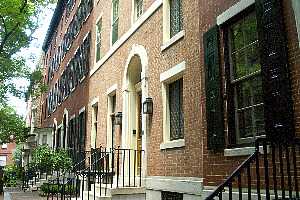
|
| Delancey Street |
It thus comes about that large numbers of very large houses have been sold for very modest prices, and the urban pioneers have gentrified them. You can buy a lot of house for comparatively little if you are willing or able to restore the building. We thus come back to Frank Furness, who was the idolized architect of the Rittenhouse Square area, in addition to the massive banks and museums for which he is perhaps better known. Unfortunately, most of the Furness mansions on the square have been replaced by apartment buildings, but one outstanding example remains. It's sort of dwarfed by the neighboring high-rises, but it was originally the home of a railroad magnate, a few houses west of the Barclay Hotel, and it holds its own, defiantly. Inside, Furness made clever use of floor-to-ceiling mirrors to diffuse interior light and make the corridors seem wider. Although electric lighting made these windowless row houses bearable, modern lighting dispels what must have been originally a dark cave-like interior on several floors, held up by poured concrete floors. Furness liked to put in steel beams, heavy woodwork, and stonework, in the battleship school of architecture. If you were thinking of tearing down one of his buildings, you had to pause and consider the cost of demolition before you went ahead.
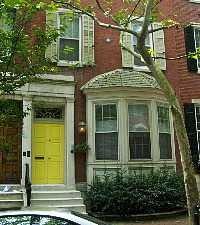
|
| Frank Furness Window |
There are several others of his buildings around the corner on the way to Delancey Street, one of them set back from the street with a garden in front. That's what you expect in the suburbs, but the land is too expensive in center city for very many of them; this is the last one Furness built before rising real estate costs drove even him back to the row-house concept. On Delancey Street, there is a house which he improved upon by adding an 18-inch bay window in front. The uproar it caused among the neighbors is still remembered.
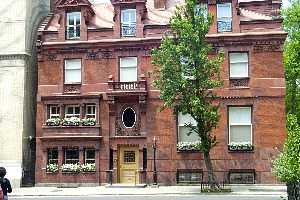
|
| Doctor Home and Office |
A block away on the part of 19th Street facing down the street, Furness built another reddish brownstone house to glare back at the neighbors. The facings of the front suggest three-row houses, and it was indeed the home of a physician who had his offices on one side, entrance in the middle, and living room on the right. The resulting staircase in the middle is used to good effect by opening a balcony on the landing overlooking the parlor below. As befits the Furness style, the wall is thick, the wooden beams heavy. And, in a gesture to the lady of the house, the room adjoining the living parlor is a modern kitchen so the kids can play while mama cooks or guests can wander by as she gets dinner ready. Times have changed, the servants quarters once were plain and undecorated. The lady of the house never set foot in the kitchen so she could care less what it looked like.
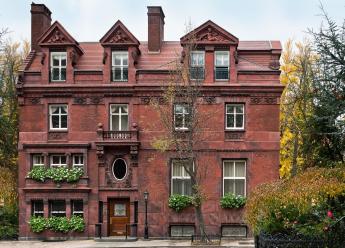
|
| Frank Furness Home |
As a matter of fact, that's the remaining problem for these places, the rate-limiting factor as chemists say. Automatic washers, microwaves, electric sweepers, spray-on cleaning fluids and similar advances are the new industrial revolution which makes these hulking mansions almost practical. What's still lacking is the social structure of Upstairs and Downstairs, the servant community overseen by the lady of the house, who once was sort of the Mayor of a town. The lady of the house is now a partner in a big law firm, or similar. It simply is not wise to leave a big expensive place unattended by someone constantly supervising the domestic help. It is never entirely safe to leave the financial affairs of the household in the hands of someone who is not a central member of the owning family. Perhaps the father of the family can be brow-beaten into spending some quality time with the children once in a while.
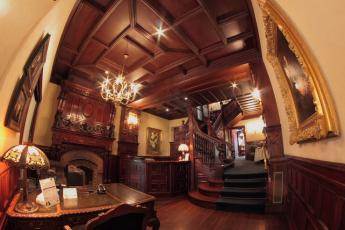
|
| Structure of Upstairs and Downstairs |
Perhaps an accountant can for a fee be trusted with the finances; perhaps a butler can be found who will whack the staff when they get out of line. But the plain fact is these monster houses were built around the assumption that the lady of the house would run them, and the old style of manorial life cannot return unless the house is completely redesigned for it. Someday, perhaps a genius of the Frank Furness sort will make an appearance, change everything, and make everybody want to have it. But it is asking for something else when you insist on this happening in an old stone fortress that was designed to house a different style of life.
Hospital Elevators
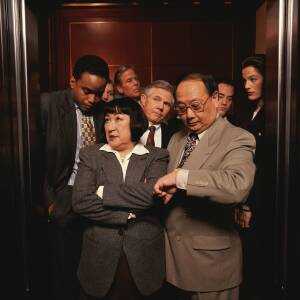
|
| Modern, High-Speed Elevator |
Elevators are a problem for any architect in any building, because they are expensive in a number of ways. If the building is no more than four stories high, it can manage to have hydraulic elevators, quite sturdy and comparatively inexpensive, but agonizingly slow. Taller buildings need high-speed electric versions, but the elevator itself is not the most expensive part. More important is that every elevator bores a hole in every floor, more elevators bore more holes, and the usable floor space on each floor is reduced. Further, the mechanical stress is mostly on the doors on each floor, which open and close hundreds of times each day, rather than the lifting engine of the cab. Elevators which seem to be breaking down continually, are mostly in need of new doors. In building a hospital, the architect confers closely with the administrator until the place is built and then the architect leaves. The administrator may leave soon afterward, too, because the hospital personnel who use the new building soon discover that when pennies were pinched, the result was fewer elevators. There's no right answer to this problem; nobody is ever satisfied.

|
| Waiting for the Elevator |
The surgeons long ago learned to cope with the problem by beginning their day before everyone else arrives. If the elevator comes immediately after being summoned and skips all intervening floors to the surgeon's destination, it can save at least a half hour of his time to make rounds at 5 AM. Multiply that imposed delay on hundreds or thousands of hospital employees, and it is possible to conjecture that hospital employees generally only work a 7-hour day, and spend the 8th hour waiting for the elevator. Whatever the actual calculation, it is a cost seldom actually calculated into the equation of constraining the installation of elevators because of cost considerations. Unwelcome crowding is a social cost, too. Bereaved relatives coming down in the elevator must meet students of various disciplines going up the elevator holding coffee cups and chattering. And all ranks and conditions must crowd into the unyielding back of the elevator when the door opens to confront a hospital bed with an afflicted patient aboard, surrounded by a team of attendants in pajamas, holding up bottles and tubes. Attempts are usually made to assign separate elevators for patients and/or equipment, but the attendants soon find out about elevators that save time, flocking to them in spite of signs, threats, administrative letters of admonishment, and dreary staff meetings. It is easy to identify new staff; they are the people who take elevators down. Everyone else learns to go to the top floor and walk down the stairwells. Outta my way!
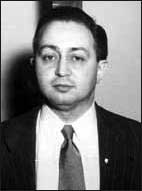
|
| Harry Gold |
So, hospital elevators evoke recollections. Mine include the many times I rode up beside a sullen teenager named Harry Gold, who was going to the chemistry department of the old Philadelphia General Hospital. If we ever exchanged a word I don't remember it, so I have to regret that I missed out on striking up an acquaintance with a real, convicted Soviet spy, the one who passed hydrogen bomb secrets to those Rosenbergs who went to the electric chair protesting their innocence. Something to tell my grandchildren I guess.
On another occasion, Dr. John Y. Templeton was standing impatiently for an elevator at Jefferson Hospital. John was a brilliant surgeon from Virginia, one of the inventors of the heart-lung machine, and also one of the quickest, most irreverent wits in Medicine. The door of the elevator opened, to reveal a completely crowded crowd of assorted folk, with a Doctor Zimskind standing in the front. Templeton's southern accent boomed out, "Going down?" "Going dow-un?" Lost in thought, Zimskind had trouble finding his voice and simply poked his index finger skyward two or three times. To which, Templeton shouted out, "The same to you, Dr. Zimskind. But are you going dow-un?"
And, much earlier when I was a resident wearing a long white coat, accompanied by a jolly sort named Carroll who wore the same, we got on an elevator which was empty except for a surgical resident wearing his particular uniform of a short white coat covering his green surgical pajamas. We had gossiped earlier about this surgeon, who had returned for training after some harrowing experiences in the Normandy beachhead. He was a mean, silent, sort, but Carroll was an irrepressible joker. "Well," sez Carroll, "I hear you carry a gun around with you. Do you carry it into the operating room?" To this, the surgical resident opened his jacket and, so help me, pulled out a pistol from his belt. "When I was in Germany," he murmured, "I killed lots of better men than you are." Under the circumstances, there was little more to be said, and we stopped breathing just to be sure. Those Jefferson elevators are awfully slow to reach the next floor.
And finally, there was Herman, who ran the hydraulic elevator in the original old building of the Pennsylvania Hospital. Herman the German we called him, although his accent was probably Central European. This elevator was an antique, with a big iron steering wheel that Herman turned to release the oil or water or whatever pumped the excruciatingly slow cage up two floors. There, for our contemplation, was America's first building of the first hospital, with the first operating room on the top floor. For more than a century, orderlies had to carry stretchers up and down the stairs with the apprehensive surgical patients, and then this marvel of a hydraulic thing was installed to great admiration. It has long been replaced with a fancy new self-service elevator. But so have the patients been replaced; one hundred sixty patient beds entirely replaced by administrators.
New Museum of Chemical Heritage
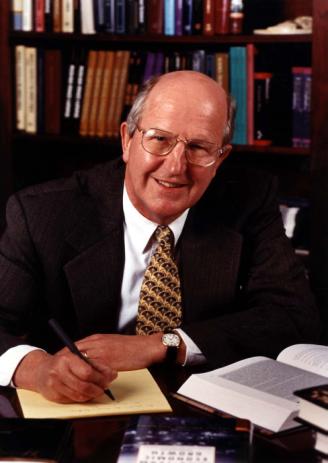
|
| Arnold Thackray |
Eighty percent of the ethical drug industry is located within a hundred miles of Philadelphia, and the whole chemical industry has had its center here for two centuries. The chemical industry is the region's largest manufacturer, now that locomotives and beer brewing have come and gone, but its profile remains low. In fact, chemists personally have a low profile too and harbor a smoldering annoyance about it. No one has been more determined to change that nerdy image than Arnold Thackray, the recently retired President of the Chemical Heritage Foundation. He's not only a big idea man but bubbles with energy and persuasiveness. That largely accounts for the fact that CHF has the second largest endowment among public institutions in Philadelphia, the best library of chemical history in the world, and a growing reputation for fine art concentrated in the field. That's not enough for him, so it came about that a new museum was envisioned, funded and created. But not built; building it was assigned to Miriam Schaefer, a famous go-getter who had the unusual qualification of being squeamish about chemistry. It was her assigned task to find a way to make chemistry exciting to people who were not instinctively excited by it, just exactly because she was the world's authority on that point of view. What was vital was that she was the sort of person who can't resist a challenge, and was capable of thinking, well, big.
With the unlimited backing of Arnold and his board and their almost unlimited financial support, Miriam set about soliciting big ideas from uninhibited people all over the world, and some of their suggestions were even a little too wild to be acceptable. But since the whole idea was to awaken the enthusiasm of anybody, however sullen, who happens to shuffle through the museum, many outlandish suggestions were forced through the filter of a skeptical, conservative, Philadelphia establishment. The result is a series of pleasant surprises, ranging from fine art with a focus on alchemists trying to make gold out of lead, to astonishing computerized graphic displays of the elements of the periodic table fifty feet high, to depictions of Joseph Priestly known as the father of chemistry, a personal friend of Benjamin Franklin, the founder of the Unitarian Church, and a resident of Philadelphia. There's Arnold Beckman's original Beckman spectrophotometer which made hundreds of millions of dollars, was a major factor in the Twentieth century blossoming of biochemistry, and is here shown to be a clever elaboration of a simple idea. Meanwhile, the museum is housed in a massive old bank building, with it is interior reamed out and replaced with as much transparent glass as could support the weight. Inga Saffron the architectural critic, more than foamed over with praise in her review of just the structure itself. Don't neglect to notice the stunning portrait of Gay-Lussac, the man who discovered that water is H2O. The pigments of his portrait were mixed with beeswax, and with clever lighting have an astonishing luminosity.
The museum is part of an emerging conference center, which should attract audiences of chemists for decades. But that's not entirely the whole idea. The underlying vision is to convince those skeptical, non-chemical bozos that not only are chemists rather richer than the rest of us, and smarter, but clever and fascinating, too. Go visit this museum, before everyone else does.
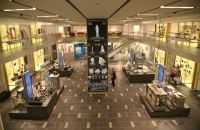 |  | 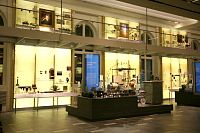 |
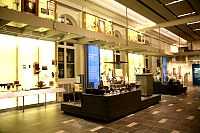 | 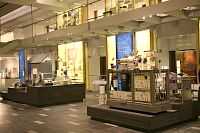 |
Water Works, Emblem of the Past
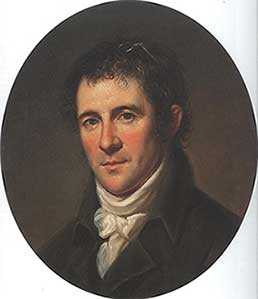
|
| Benjamin Henry Latrobe |
Philadelphia didn't really want the national capital to move to Washington DC, but the yellow fever epidemics, brought from Haiti by refugees, made it politically impossible to reverse the decision to move. We now know that Yellow Fever is transmitted by mosquitoes, but there were enough trash and pollution lying about the that it was plausible that polluted water was the cause. With no time to waste, water was piped in, through wooden pipes, from the comparatively pristine Schuylkill to a pumping station in Center Square, where City Hall now stands. Even today, no one wants a water tower in the neighborhood, so Benjamin Henry Latrobe made it look like a Roman Temple, thereby introducing classical architecture to Philadelphia, and starting quite a trend. The new system worked well enough from 1801 to 1815, when the new city outgrew it. Therefore, a new pumping system was built at the base of Faire Mount, where William Penn once planned to have a mansion, and was attached to Latrobe's wooden pipe system. In a unique and ingenious way,
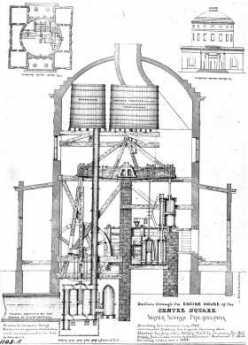
|
| Latrobe Water Works |
Frederic Graff pumped Schuylkill water up to a series of reservoirs on top of Faire Mount, utilizing a water stack to maintain constant pressure. The classical architecture was continued, parks and decorative gardens were placed around it, and admirers came from around the world to marvel. Meanwhile, Latrobe's original building could now be torn down, providing room for City Hall, which was planned to be the tallest building in the world, although the French sort of cheated and put up Eiffel Tower, which in a sense really isn't a building. Meanwhile, Philadelphia and the rest of America kept growing and growing, leading to industrial plants along the Schuylkill all the way up to Pottsville, where the anthracite came from. The pure sparkling municipal water of which Philadelphia was so proud soon became a stinking sewer, and the Civil War encampments accelerated the process.

|
| Frederic Graff |
Following the lead of the Philadelphia College of Physicians, the concept of Fairmount Park emerged from clearing the banks of the river, and the Wissahickon Creek, of industry. The Philadelphia Water Works thus became the southern anchor of the largest city park in the world, including the building of Laurel Hill Cemetery, which had sanitary overtones which were embarrassing to discuss. Philadelphia led the world in adapting to this particular feature of the Industrial Revolution, and the insights of Louis Pasteur. By 1890, however, the system was again outmoded, and Philadelphia water became the butt of every joke. Between 1815 and 1840 the wooden pipes were replaced by iron ones. Robert Morris's old estate of Lemon Hill was acquired by Fairmount Park and used to construct a second reservoir on the neighboring hill. More about that second reservoir, in another blog.
Eventually, there would be more reservoirs at Belmont and Green Lane. But the city's new reputation for foul water was deserved. Deaths from typhoid fever rose to 80 per 100,000 residents before a water filtration system was installed; deaths from typhoid promptly fell to 2 per 100,000. Statistics on hepatitis were not available, but virus diseases must have been a serious hazard under primitive conditions of filtration, aeration and chlorination -- as they still are in many third-world countries, and in most southern European nations before 1950. As late as 1950 in Philadelphia, it was considered witty for a dowager to accept a drink from her hostess, saying "I'll drink absolutely anything, except Philadelphia water -- and 'Coke' ". The implication was that alcohol sterilizes water, which of course it doesn't, and also that absolutely everybody knows that Philadelphia has terrible water, whatever that means.
A reputation like that is bad for the city, making it harder to persuade workers and business to locate here, but the traditions underlying this response are quite ancient. Back in the days when water came from your own well, whole neighborhoods would move to new unspoiled areas to seek cleaner water and regions where the local privies were not yet mature. It takes quite a lot to persuade people to abandon the investment in a home or mansion as in Society Hill, and build a new one in a nearby undeveloped region. Particularly when the germ theory was not yet available to explain the issues with precision, pulling up stakes for a new neighborhood was an accepted reaction to almost any threat.
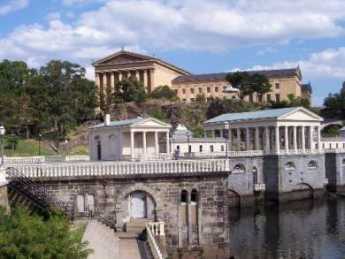
|
| Water Works Today |
However, strenuous exertions for half a century have made Philadelphia water safer, tastier, and far cheaper than bottled water. The recent trend of young people to walk about sucking a three dollar bottle of water drives the Philadelphia Water Department up to a wall. For example, 25% of bottled water comes straight from the tap. The inspection standards for public water are much stricter than for commercially bottled water, whose safety is in large part secondary to the safety of the tap water from which it is derived. True, public water is chlorinated, but then it is also fluoridated, putting legions of dentists out of business. In Philadelphia, that's the main difference justifying the rather appalling price difference, and the accumulation of plastic bottles in various trash heaps.
The recent advances in Philadelphia's water can in part be traced to Ruth Patrick, now over a hundred years old but the world's foremost expert on streams and water, and to the persistent professionalism of the Philadelphia Water Department. Perhaps, though, it may take a century of slander about water to persuade the politicians to keep their hands off the Water Department. It does take a lot of tax money to implement the third step in the process of cleaning up the water supply, which is the purification of wastewater. For centuries, the guiding principle was to obtain and maintain pure water at the source; wastewater was flushed down the sewer to go back out to the ocean. However, seven times as much water is removed from Delaware, as it flows past the city. That is, the water now recirculates through the sewage system seven times before it is turned over to residents of lower Delaware Bay. The expensive and elaborate -- but scarcely visible -- system of treating sewage in various sewage treatment centers has now resulted in returning water to Delaware in better condition of purity than it had when it came down past Bucks County.
But it costs lots of bucks, and nobody seems to notice the water. People only notice the bucks.
The University City
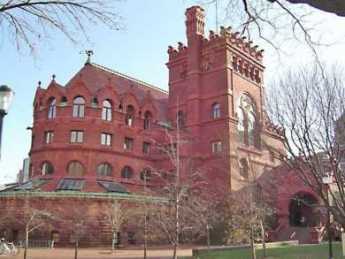
|
| University of Pennsylvania |
In 1920, the University of Pennsylvania graduated 34 students with B.A. degrees, and 134 with M.D. degrees. Today, the campus is a little self-contained city of 50,000 inhabitants. The transformation of the campus during that period is an outward expression of revolutionary expansion of the student body, involving demolitions, restorations, new construction. And the nearly constant shortage of parking space.
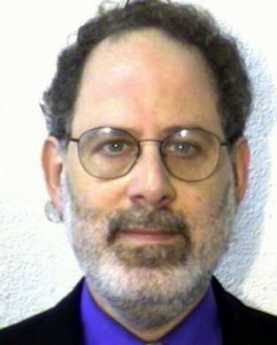
|
| David Hollenberg |
David Hollenberg, the University Architect, recently gave the Franklin Inn Club an interesting description of the University from the point of view of bricks and mortar. Since almost every building on the campus is undergoing or plans to undergo a major building project, he had a lot of material to cover. The disappearance of the railroad-based industrial area of West Philadelphia has been an economic problem for the city, but of course, this abundance of vacant land has created a major opportunity for the University of Pennsylvania. One reflection of this abundance is the opportunity to become the developer for much of the whole region around the campus, working with private developers who wish to be in the University area, and are therefore willing to coordinate their plans with those of the University. It's a remarkable opportunity. Since it comes at the time of a major economic downturn, one can only hope that the University does not impoverish itself taking advantage of this good luck.
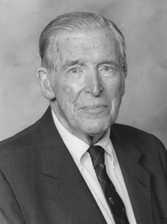
|
| Jonathan E. Rhoads |
As the graduation statistics illustrate, not so long ago the University was largely a medical school, with appendages. There are rumors of considerable friction from time to time, between the President of the University and the Dean of the Medical School as to who was boss; it is easy to imagine the trustees swinging from one side to the other. The most notable Provost of the University in modern times was Jonathan Rhoads, who also happened to be Professor of Surgery. If you know Quakers, you know that disputes were seldom rancorous. And if you know Jonathan, you know he almost always won the disputes.
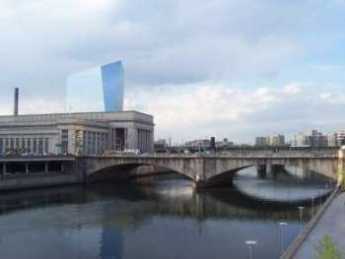
|
| Cira Center |
While today, the dominant change is caused by the Cira Center buildings and the acquisition of the former Post Office building, it is well to keep in mind that the new Cancer Center is a billion-dollar project. A great deal of the medical school expansion is centered on burgeoning research, particularly in molecular biology, largely financed by the National Institutes of Health. While the leaders of the NIH have long struggled with Congress to keep politics out of both the administration and the substance of research, it seems to old-timers that the politicians are slowly winning. Senator Specter's seniority on the Appropriations Committee may have had as much to do with the prosperity of West Philadelphia, as the quality of research, however eminent. We are about to find out, and if things go hard with us in favor of say Chicago, it could be a wrenching experience. Most of those research buildings cost more to heat, air-condition, insure and clean than the entire tuition base of the students; and they wouldn't be good for much if you tried to sell them.
The University is almost unique in being located on contiguous land, near existing public transportation, and occupying substantial old structures capable of renovation to new purposes. Mr. Hollenberg was asked whether it was cheaper to grow like this within a city, or whether it is cheaper to plant a totally new university in several open corn fields, as we often see happen. While this is a hard question to answer, and depends to some extent on the type of architect in charge, it is his view that big-city restoration is a considerably cheaper way to expand than building from scratch on open land, although if you are starting the institution itself from scratch, there isn't much choice but the cornfield.
And then, there is the ancient argument between academics and bricks and mortar. Development officers agree that it is easier to raise donations when you can name a building for the donor; grand visions for new frontiers of teaching are a much harder sell. So a question does hang over this expansion, however exciting, whether the endowment will keep up with the structures, once the excitement of physical expansion dies down. These are definitely things to worry about, but right now you seize the opportunities as they go past, leaving integration to your successors to figure out.
------------------------------------------------------------------------------------------------------------------------Pyramid-Building, Greatly Simplified
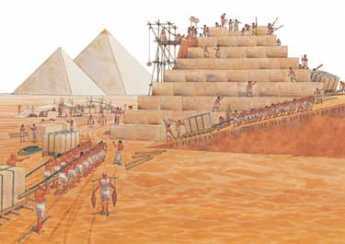
|
| Egyptian pyramids were supposed to be built |
Everyone who went to Sunday School knows the Egyptian pyramids were supposed to be built by huge numbers of slaves, quarrying stone blocks, transporting them with only crude rollers, and setting them precisely in place under the supervision of slave-drivers with whips. The number of stones has been estimated, a reasonable time estimate made for carving a block, and modern scholars have calculated that every single person in Eqypt must have been either a slave or a slave-driver. In fact, there is a theory among British scholars that such a mobilization of the entire nation could only have been motivated by religious fanaticism, since it's so hard to imagine keeping a nation at work involuntarily in the hot sun for twenty or more years, even with whips.
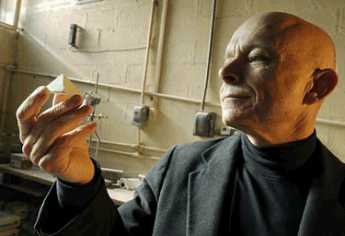
|
| Michael Barsoum |
As recently described to the Right Angle Club by Professor Michael Barsoum of the Ceramics Department of Drexel University, we probably have to revise our views. A "Eureka" moment seems to have first arrived for a French Professor named Joseph Davidovits several years ago, with the thought that perhaps the building blocks of the pyramids may have been cast in place rather than carved. Poured concrete, so to speak, rather than carved out of a quarry and pushed over the desert in some fashion and hauled up into place. Since the blocks seem precisely chiseled to fit together exactly, it has always been hard to imagine how this was done, when the Egyptians were thought to have no iron tools, only pure copper as a metal ingredient, not even bronze.
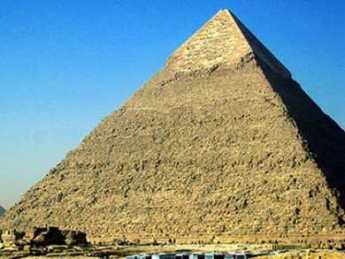
|
| Khufu Pyramid |
The insight was brilliant, although the evidence for it was weak, and it has been pretty easy to pick holes in the proposal. Poured concrete is much easier to reconcile with the remarkable leveling of the stone blocks, where the bottom level of the Khufu pyramid is the size of eight football fields but only varies from true level by one inch overall. Exploratory cuts into the sides of the pyramids reveal the component stones to vary enormously in size and shape in the interior, although the exterior surface is quite smooth. Similarly, the lateral sides of the pyramids vary from true north by only 1/15 of a degree, a remarkable achievement for stone cutting with primitive tools. Broad Street in Philadelphia supposedly runs North and South, for example, but it deviates from true north by six degrees. The pyramid builders, like the architects of ancient Beijing, must have used the Pole Star for orientation, rather than a magnetic compass.
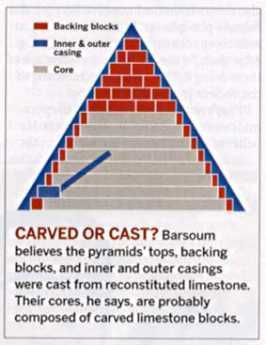
|
| Carved or Cast |
While Davidovits got this line of thinking started, Michael Barsoum has considerably advanced the proof of idea by addressing a large number of nitty-gritty questions about just how all this might have been accomplished. For example, the science of ceramics shifted the idea from the Portland Cement model to a recognition that the calcium in the cement came probably from diatomaceous earth, which is to say the crushed skeletons of diatoms on the ocean floor. Microscopic examination of the cement reveals large numbers of intact diatoms, with the cement layer surrounding the limestone aggregates. Furthermore, analysis of the stones shows that the outer shell of the pyramid was cast concrete, but the interior main mass was composed of stone rubble of various sizes and shapes. The apex of the pyramid was pure casting, probably because of the difficulty of fitting exterior and interior stones at the point. So, the Drexel team carried Davidiovits' idea from a general concept to a practical description of how the construction was probably accomplished. Carbon dating was attempted, but this technique stops being accurate for such remote time periods.
To nail down the idea that Philadelphia really explained how to build pyramids, funds are being collected for the construction of a 27-foot model pyramid in Logan Square. Let's hope the community gets behind this effort, which is both scholarly and entertaining, with an element of international competition mixed in. After all, Philadelphia is still smarting from the erection of the Eiffel Tower, six feet higher than Philadelphia City Hall, as the tallest structure in the world at that time. Let's be clear about it: the Eiffel Tower was the tallest structure in the world, while our City Hall remained the tallest building.
Re-Doing Dilworth Plaza
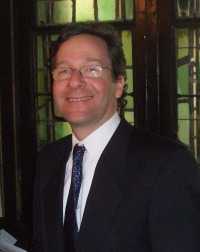 |
| Richard Maimon |
Richard Maimon recently visited the Right Angle Club to tell us all about the architectural plans afoot to consolidate the underground transportation network underneath City Hall, change the patterns of foot traffic, open up the views, and draw the visitors to the expanded convention center into the city itself. All of this is to be accomplished by paving over Dilworth Plaza and planting it with grass, along with an extensive fountain installation which can be used for winter ice skating. In the course of creating an entrance hub for Septa, the Broad Street and Market subways, walkways are rearranged and -- it is hoped -- the foot traffic around City Hall will shift around to make it a real city center. It's a very expensive dream because of all the overlapping transportation tunnels hidden under the largest and heaviest stone building in America, leading to a great deal of expensive construction work that doesn't show.
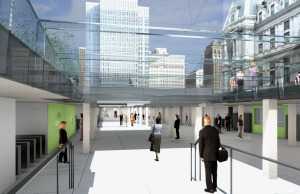 |
| interior view of concourse north_ |
Dilworth Plaza is currently almost completely deserted, so its conversion will not be much mourned. However, the mixture of contemporary transportation entrances with the neo-classical architectural style of City Hall will probably meet resistance, and there is concern that excessive foot traffic could convert a grassy park into a mud puddle, while a large open-air lake could become a public rest-room for the homeless if the designers aren't careful. To some extent, the public forces to be resisted in the design will be self-policing if the anticipated foot traffic is at the anticipated level, but overwhelmed if the project is too successful, or left to deteriorate if it fails to succeed. And it's all too expensive to do twice; the designers have to get it right the first time.
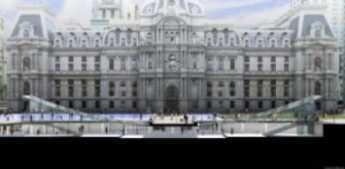 |
| Section Pavilions |
So, it all comes down to money. Construction costs are less during a recession, but raising money is easier during a booming economy. High hopes are raised for a Democratic governor to be able to persuade a Democratic president to divert stimulus money our way. High hopes are raised for a former Mayor's ability to divert state funds to our part of the state. In other words, it all depends on Governor Rendell, now that Senator Specter has navigated himself off the Appropriations Chairmanship. In our system of government, public works projects have to be placed somewhere, so the best system is to rotate the goodies in an informal way. This rotation, in turn, depends on a geographical rotation of the top political officers, since they can claim that it is "Philadelphia's turn". So, the grim reality is that only two Philadelphia mayors in history have become governors of the state, with the rather bitter result that Philadelphia has been neglected in the siting of the available public projects for a very long time. Digby Baltzell long preached that it was our own fault, for being too non-aggressive. But most of the rest of us, particularly those who have wrangled with the upstate legislature, blame the situation on narrow-minded opposition from those who have worked the gerrymandering game for a couple of centuries.
Cushman Club for Lonesome Actresses
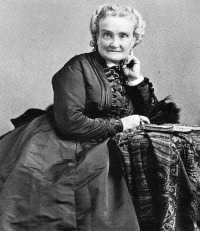 |
| Charolotte Cushman |
Lydia Ellicott Morris was married to another member of the Quaker colonial aristocracy, George Spencer Morris; both of them were active members of many organizations, including the Philadelphia Savings Fund Society, Friends Hospital, and several of the clubs on Camac Street. Their home for many years was located at 225 South Eighth Street. George Morris was a senior partner of Morris and Erskine, Architects. One day, Lydia was riding on a trolley car.
On the trolley, she overheard two young actresses fretting over the problem that traveling actresses were forced to live in hotels and boarding houses along with traveling salesmen. This circumstance forced them to experience much-unwanted attention and made being an actress a difficult occupation for respectable women. Lydia promptly got off the trolley and formed an organization raising funds to create in 1907 a boarding home to provide safe, respectable, inexpensive lodgings for actresses in traveling shows, playing in Philadelphia. It was named after Charlotte Cushman, the first internationally famous American actress, and located at 1010 Spruce Street. Charlotte Cushman had no connection with the club, but her fame can be appreciated from the fact that in 1874 after her final performance, 15,000 people were reported to have serenaded her outside of New York's Fifth Avenue Hotel. The Ninth Regimental Band played, while fireworks illuminated Madison Square. Ms. Cushman died in 1876.
Another major donor to the club was a Mr. Peterson, otherwise unidentified, who gave them $50,000. Further funds were raised at five annual teas. In 1925, Philadelphia was a major center for the film industry, and much Charlotte Cushman Club early history relates to movie associations. Much of the early endowment was unfortunately lost in the 1929 stock market crash, however, and the club continued only a subdued presence for a number of years. By 1999, it was clear that the original purpose was not really needed, and the club was disbanded. Its possessions, including the last of several clubhouses, the collections, and a rather valuable library, were sold off, and most of its other belongings were donated to the Franklin Inn Club. The club began a new existence as the Charlotte Cushman Foundation, first endowing the Charlotte Cushman Board Room and Exhibit, at the University of the Arts, and then in 2001 began making grants to local nonprofit theatre groups. At present, the Foundation dispenses an income of about $45,000 yearly among 43 non-profit theatrical societies which continue in Philadelphia. Present dominant activity is to select the Leading Actress in a Play, as part of the annual Barrymore Awards. The rise of the club reflected the vibrant downtown social life of Philadelphia at a time when almost all Philadelphians were residents of the center city. And its decline parallels the loss of civic-minded center city residents following the spread of household automobiles and the continuing wreckage of traditional civic feeling following the 1929 crash.
The Foundations's website is www.charlottecushmanfoundation.org, and its email address is CharlotteCushmanFoundation@gmail.com
What's Different About Kosher ?

|
| Kosher Foods |
About half of the labeled food products in a typical supermarket are designated Kosher, displaying a "K". That seems remarkable when only about 1 million American Jews are observant or Orthodox, thus eating only Kosher food for religious reasons. So, the Chemical Heritage Foundation recently decided it would be interesting to examine the definition and details of the Kosher designation, which presumably has some chemical basis. The CHF was right about the interest in the topic; attendance at the auditorium was packed. The following is entirely derived from what was discussed there.

|
| Rabbi |
One might have carelessly supposed that a religious designation of food products would have an exclusively religious basis, probably related to preparing the product according to a religiously defined method or ceremony. That's essentially true, but what is unexpected is that the choice of food to be included or excluded must obey a strict and extensive set of rules. The basis for the rules is found in the Old Testament, but specifics have been evolved by designated Rabbis, rather like the way the interpretation of the U. S. Constitution is left to the U.S. Supreme Court, and has considerably evolved in the process. An examination of these evolved rules is what leads other denominations of Jews to avoid the issue or even to decline to endorse it. That makes it rather awkward for chemists to understand the Kosher process in strictly chemical terms. For a perhaps extreme example, hard cheese but not soft cheese is strictly forbidden within Kosher rules. That's because the rules state that eating meat is fine, eating cheese is fine, but six hours must elapse between eating either one. What's forbidden, then, is a mixture of meat and dairy. Hard cheese is produced by exposing soft cheese to rennin, or rennet. Rennin is produced from the stomach of cows, so the interaction is deemed to be simultaneous rather than separated by more than six hours. It certainly is true that a chemical reaction between two ingredients is difficult to imagine if it is anything but a simultaneous contact between the two. So, chemists would have to agree that hard cheese involves less than a six-hour separation between meat and dairy. But most chemists would regard this interpretation to be somewhat strained; to punish people for disregarding it seems excessive. Whatever disagreement there may be is not based on the facts, but on the importance to be attached to them.
Similarly, most chemists would resist the idea that a chemical product derived from two different sources differs in any way at all. The most important example of this issue is glycerine, a common food additive. A fat consists of three fatty acids attached to glycerin; pure glycerin is produced by separating the fatty acids from it, and in any event, the fatty acids of pigs and cows are also chemically identical, at least in the view of chemists. Glycerin derived from pig fat thus seems to chemists to differ in no meaningful way at all from glycerine derived from cow fat. To those in charge of Kosher rule making, however, the difference in the source is vital, needing to be searched out in minute detail. Since Coca-Cola contains traces of glycerin, and the Coca-Cola manufacturer wished to have a Kosher label, the company somehow had to satisfy the Rabbinical demand that the sources and processing steps of the glycerin be identified in minute detail. Coca-Cola contains a secret ingredient which some believe is essential for the true Coke taste; the company was not going to reveal its processes. Somehow, this quarrel was resolved privately, although it is not easy for outsiders to imagine how it could be.
And so on. There may, of course, exist many Kosher rules which make perfect sense; the speakers did not go into that. What remains of general interest is the question why so many non-Orthodox Jews, in fact so many people who are not Jewish in any sense, insist on eating only food with a Kosher label. At the conference, it was explained that many people who have been told they are lactose-intolerant, or allergic to some protein, become fanatic in their fear of contact with such chemicals. That is, as a matter of fact, a common observation in many doctors' offices. These people seem to have developed the idea that they can trust the Orthodox rabbis to be even more fanatic than they are if anything more rigid and unyielding in their pursuit of particular exclusions. While that has driven many Jews away from Orthodoxy into other religious directions, it has served to reassure the health fanatics. The food manufacturers don't particularly care about the social features; if that "K" sells the product, they want to have it.
On hearing of these issues, one of my Jewish friends suggested an extension to Jewish kitchens. It was his view that if a real estate agent shows you a house with two or more ovens, two or more stoves, or even two or more kitchens, it probably had a Jewish owner at some time in the past. Multiple kitchen arrangements are much less likely to reflect an owner who likes to entertain a lot, than an owner who has been told of the six-hour mandatory wait between eating both meat and dairy, and has persuaded himself this rule extends to the separation of stoves. There's no great harm in any of these beliefs, of course, unless it is somehow represented that they improve the health of the believer, which would drag a highly reluctant Food and Drug Commissioner into a dispute he can't win, no matter how he rules.
Whatever the complete truth of all these suppositions, they lead the casual reader to let his thoughts meander. There's a similarity here to a great many other prohibitions and adherence, tenaciously adhered to, resulting in elections won and lost, provoking scorn heaped on non-believers. And even to totally unrelated legislation getting derailed because legislative representatives were unwise enough to take a stand on this one. Pro or con.
Existing Websites Which Offer Higher Education
Immense: Here are a few of my favorites--
https://ocw.mit.edu/OcwWeb/web/home/home/index.htm
https://mitworld.mit.edu/browse
https://www.youtube.com/user/MIT
https://numericalmethods.eng.usf.edu/
https://www.apple.com/education/itunes-u/whats-on.html
Heron Rookery on the Delaware
 |
| Great Blue Heron |
When the white man came to what is now Philadelphia, he found a swampy river region teeming with wildlife. That's very favorable for new settlers, of course, because hunting and fishing keep the settlers alive while they chop down trees, dig up stumps, and ultimately plow the land for crops. As everyone can plainly see, however, the development of cities eventually covers over the land with paving materials; it becomes difficult to imagine the place with wildlife. But the rivers and topography are still there. If you trouble to look around, there remain patches of the original wilderness, with quite a bit of wildlife ignoring the human invasion.
 |
| Heron Nests |
Such a spot is just north of the Betsy Ross Bridge, where some ancient convulsion split the land on both sides of the Delaware River; the mouth of the Pennypack Creek on the Pennsylvania side faces the mouth of the Rancocas Cree on Jersey side. In New Jersey, that sort of stream is pronounced "crick" by old-timers, who are fast becoming submerged in a sea of newcomers who don't know how to pronounce things. The Rancocas was the natural transportation route for early settlers, but it now seems a little astounding that the far inland town of Mt. Holly was once a major ship-building center. The wide creek soon splits into a North Branch and a South Branch, both draining very large areas of flat southern New Jersey and making possible an extensive network of Quaker towns in the wilderness, most of whose residents could sail from their backyards and eventually get to Europe if they wanted to. In time, the banks of the Rancocas became extensive farmland, with large flocks of farm animals grazing and providing fertilizer for the fields. Today, the bacterial count of Delaware is largely governed by the runoff from fertilized farms into the Rancocas, rising even higher as warm weather approaches, and attracting large schools of fish. My barber tends to take a few weeks off every spring, bringing back tales of big fish around the place where the Pennypack and Rancocas Creeks join Delaware, but above the refineries at the mouth of the Schuylkill The spinning blades of the Salem Power Plant further downstream further thin them out appreciably.
Well, birds like to eat fish, too. For reasons having to do with insects, fish like to feed at dawn and dusk, so the bottom line is you have to get up early to be a bird-watcher. Marina operators have chosen the mouth of the Rancocas as a favorite place to moor boats, so lots and lots of recreational boaters park their cars at these marinas and go boating, pretty blissfully unaware of the Herons. Some of these boaters go fishing, but most of them just seem to sail around in circles.
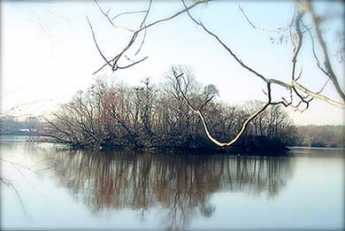 |
| As Seen From Amico Island |
Blue herons are big, with seven-foot wingspreads as adults. Because they want to get their nests away from raccoons and other rodents, and more recently from teen-aged boys with 22-caliber guns, herons have learned to nest on the top of tall trees, but close to water full of fish. And so it comes about that there is a group of small islands in the estuary of the Rancocas, where the mixture of three streams causes the creek mud to be deposited in mud flats and mud islands. There is one little island, perhaps two or three acres in size, sheltered between the river bank and some larger mud islands, where several dozen families of Blue Herons have built their nests. One of the larger islands is called Amico, connected to the land by a causeway. If you look closely, you notice one group of adult herons constantly ferries nest building materials from one direction, while another group ferry food for the youngsters from some different source in another direction. At times, diving ducks (not all species of ducks dive for fish) go after the fish in the channel between islands, with the effect of driving the fish into shallow water. The long-legged herons stand in the shallow water and get 'em; visitors all ask the same futile question -- what's in this for the ducks? The heron island is far enough away from places to observe it, that in mid-March its bare trees look to be covered with black blobs. Some of those blobs turn out to be heroes, and some are heron nests, but you need binoculars to tell. When the silhouetted birds move around, you can see the nests are really only big enough to hold the eggs; most of the big blobs are the birds, themselves. There are four or five benches scattered on neighboring dry land in the best places to watch the birds, but you can expect to get ankle-deep in the water a few times, and need to scramble up some sharp hills covered with brambles, in order to get to the benches. In fact, you can wander around the woods for an hour or more if you don't know where to look for the heron rookery. Look for the benches, or better still, go to the posted map near the park entrance south of the end of Norman Avenue. There are a couple of kiosks at that point, otherwise known as portable privies. Strangers who meet on the benches share the information supplied by the naturalists that herons have a social hierarchy, with the most important herons taking the highest perches in the trees. That led to visitors naming the topmost herons "Obama birds", and the die-hard Republicans on the benches responding that the term must refer to dropping droppings on everybody else. That's irreverent Americans for you.
There is quite a good bakery and coffee shop just north on St. Mihiel Street (River Road), and the new diesel River Line railroad tootles past pretty frequently. That's the modern version of the old Amboy and Camden RR, the oldest railroad in the country. It now serves a large group of Philadelphia to New York commuters, zipping past an interesting sight they probably never realized is there because they are too busy playing Hearts (Contract Bridge requires four players, Hearts are more flexible). However, there's one big secret.
The birds are really only visible in the Spring until the trees leaf out and conceal them. Since spring floods make the mud islands impassible until about the time daylight savings time appears, there remains only about a two-week window of time to see the rookery, each year. But it is really, really worth the trouble, which includes getting up when it is still dark and lugging heavy cameras and optics. Dr. Samuel Johnson once remarked that while many things are worth seeing, very few are worth going to see. This is worth going to see.
And by the way, the promontory on the other side of the Rancocas is called Hawk Island. After a little research, that's very likely worth going to see, too.
Bergdoll the Rich Draft Dodger
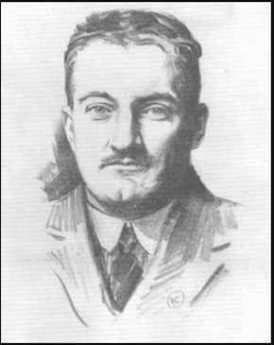
|
| Grover Cleveland Bergdoll |
Grover Cleveland Bergdoll was one of the great playboys during the era between the Spanish American War and World War I. Although the money came from his beer-baron father, he was in the newspapers as one of the early owners of an airplane, one of the dare-devils racing about in open cars, and of course successful with girls.
His father Louis (1825-94) had emigrated from Germany, bringing with him the new technique of making lager beer by brewing it in the cold, and quickly exploiting its popularity into thousands of barrels of beer a day. Although it is always hard to say just who invented a technique like that, there seems little doubt that Bergdoll & Schemm was responsible for transforming the area north of Spring Garden Street into a booming area of breweries, consuming huge amounts of ice and ice water, wood staves for beer barrels, horses to drag beer to the beer gardens, and energizing railroads to import raw materials and carry away the barrels of beer. The refrigeration industry flourished and spread out into air conditioning. Bergdoll was a mighty force in Philadelphia industry.
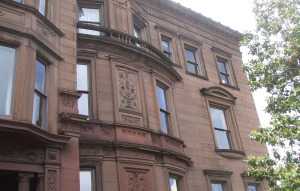
|
| Bergdoll Mansion |
The Bergdoll house was located on 21st Street, not far from the Eastern State Penitentiary, in the very upscale neighborhood called Fairmount. The neighborhood was isolated by the "Chinese Wall" of the Pennsylvania Railroad, and more importantly by the slashing through of the Benjamin Franklin Parkway. Eventually, the advent of Prohibition destroyed Philadelphia's brewery industry and its associated beer gardens. The Fairmount region declined into a slum, particularly after the 1929 Stock Market Crash, and upper crust Philadelphia fled blocks and blocks of huge mansions, too big to heat and clean, and also too big and substantial to tear down. So the Bergdoll mansion has been there all along, but there was just no one around to look at it. With the gentrification of the Fairmount region at the turn of the 21st Century, there it sits. a brownstone Pyramid, or Parthenon. A lot of wild stories circulate in the neighborhood, but very few of the new neighbors know very much about it.
It's just possible that the brownstone Widener mansion on North Broad Street is bigger, and certainly the Elkins, Stotesbury and Montgomery mansions in the far suburbs are a lot bigger. But this brownstone edifice in the center of town is impressively large enough to count for something, filling roughly half a square block if you include what look like stables of the same architectural style, and the double houses which suggest some members of the family lived next door. Even these smaller outbuildings are a great deal larger than the average city mansion.
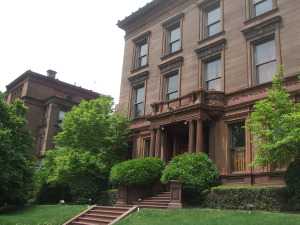
|
| Bergdoll Mansion |
The size of the place makes it easier to understand how Grover Cleveland Bergdoll could be hidden there as a draft dodger for years. In fact, local rumor often has it that he stayed there for thirty years, but it was really only about three. A book by Roberta E. Dell, called The United States Against Bergdoll supplies considerably more detail. One has to suppose that this strongly German family was opposed to American participation in World War I, and the government's violent reaction to his draft objection reflected concern that the very large German-American population might rise up and interfere with Woodrow Wilson's decision to enter the War on the Allied side. In any event, Grover's mother hid him away in the extensive mansion complex until that war seemed safe over, but he was immediately apprehended and put on trial when he emerged. Somehow or other, he managed to convince the authorities that he should be released under guard in order to go dig up an enormous fortune in gold that he had buried. The agents guarding him were put up as guests in the big mansion, apparently unable to resist the big treat. But it was a ruse, a getaway was waiting and off he sped, ending up in exile in a little town a few miles from Heidelberg, Germany. It was there that he married a local German girl and spent an apparently comfortable exile until after the Second World War. There were rumors and stories, however. A couple of kidnappers broke in on him in an apparent effort to take him over the French border, but Bergdoll killed one of them. Even after World War II, all was not forgiven; he came home, was immediately apprehended and tried, and spent a brief time in jail. He died in 1966.
Those who are sufficiently fascinated by his story, can even live in his house. It's been renovated, and rents out as Bergdoll Mansion Apartments.
Selling Entire Towns
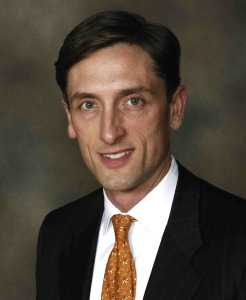
|
| Jason Duckworth |
Recently, Jason Duckworth of Arcadia Land Company entertained the Right Angle Club with a description of his business. Most people who build a house engage an architect and builder, never giving a thought to who might have designed the streets, laid the sewers, strung out the power and telephone lines, arranged the zoning and otherwise designed the town their house is in. But evidently it is a very common practice for a different sort of builder to do that sort of wholesale infrastructure work -- privatizing municipal government, so to speak. A great deal of what such a wholesale builder does involves wrestling with existing local government in one way or another, getting permits and all that. In a sense, the existing power structure is giving away some of its authority and does so very cautiously. Sometimes that involves suing somebody or getting sued by somebody. Perhaps even greater braking-power on unwelcome change is that the wholesale builder is in debt until the last few plots are sold, and realizes his profit on stragglers. Since it often happens that the last few plots are the least desirable ones, this is a risky business. Big risks must be balanced by big profit potential, and one of the risks of this sort of privatization is that too much consideration may be given to the players at the front end, the farmer who sells the land and the builder who must keep costs down, at the expense of the long-range interests of the people who eventually live in the new town. Top-down decision making is much more efficient, but its price is decreased responsiveness to citizen preferences.

|
| For Sale |
As it happens, Arcadia specializes in towns designed to look like those built in the late 19th Century. Close together, a front door near the sidewalks, front porches for summer evenings. To enhance the feeling of being in an older village, Arcadia specifies certain rules for the architecture, to make it seem like Narberth or, well, Haddonfield. Until recently, suburban design emphasized larger plots of land, and few sidewalks, with streets often ending in cul-de-sacs instead of perpendicular cross-streets in the form of squares. The "new urbanism" appealed to those who were seeking greater privacy, revolving around the idea that if you wanted anything you drove your car to get it. Three-car garages were common, groceries came from distant shopping centers. There are still plenty of new towns built like that today, but Arcadia appeals to those who want to be close to their neighbors, want to meet them at the local small stores scattered among the houses. In the 19th Century, this sort of town design was oriented around a factory or market-place; since now there are seldom factories to orient around, the appeal is to two-income families who want to live in an environment of similar-minded contemporaries. The whole community is much more pedestrian-oriented, much less attached to multiple automobiles.
Since Mr. Duckworth mentioned Haddonfield, where I live, I have to comment that the success of living in a town with older houses depends a great deal on the existence of a willing, capable yeomanry. Older houses, constantly at risk of needing emergency maintenance, need available plumbers, roofers, carpenters, and handy-men of all sorts. Because it is hard to tell a good one from a bad one until too late, this yeomanry has to be linked together invisibly in a network of pride in the quality of each other's work and willingness to refer customers within a network that sustains that pride. A tradesman who is a newcomer to the community has to prove himself, first to his customers, and almost more importantly to his fellow tradesmen. If you happen to pick a bad one, good workmen in other trades are apt to seem mysteriously reluctant to deal with you as a customer, because you too are somewhat on trial. Maybe you don't pay your bills, or maybe you are picky and quarrelsome. In this way, the whole community is linked together in a hidden community of trust. Over time, the whole town develops certain recognizable social characteristics that a brand-new town doesn't yet need. If that time arrives without a network of reliable tradesmen, the town soon deteriorates, house prices fall, people move away.
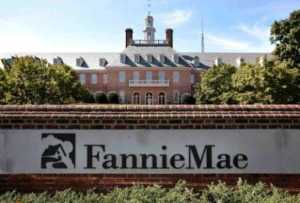
|
| Fannie Mae |
It's curious that the residents of such a town are a breed apart from the merchants in the nearby merchant strip. If the merchants of town life in that same town, there is much less conflict. More commonly, however, the merchants rent their commercial space and commute from distant places. That disenfranchises them from voting on school taxes and local ordinances and creates a merchantile mentality as contrasted with a resident community, dominated by high school students. One group wants lower taxes, the other group wants to get their kids into Harvard. One group wants space for customer parking, the other group is opposed to asphalt lots. And in particular, the residents want to avoid garish storefronts and abandoned strip malls. Since the only group which has an influence on both sides of this friction are the local real estate agents and landlords, their behavior is critical to the image of the town. When real estate interests are not residents of the town it is ominous, and they are well advised to remember that the sellers of houses are the ones who choose a real estate agent for a house turn-over. There's more to this dynamic than just that, but it's a good place to begin your analysis. Suburban real estate interests are constantly tempted to get into local politics, but politicians are the umpires in this game, and it soon becomes bad for their business if real estate agents potentially put their thumb on the scales.

|
| FHA Seal |
All politics is local, but all real estate is not entirely local. The present intrusion of the Federal Government into what is normally a purely local issue has become more pointed in the present real estate recession. Almost all mortgages are packaged and sensitized by "Fannie Mae and Freddy Mac". By overpaying for the mortgages they package, these two federal agencies are subsidizing the banks they buy the mortgages from. Or, that is half of the subsidy. The other half is the Federal Reserve, which presently lends money to banks at essentially zero interest. Acquiring free money from the "Fed", while selling mortgages to Fannie Mae at above-market rates, the federal government supports the banks at both ends. And that's not quite all; there is something called the FHA, Federal Housing Authority, which guarantees mortgages. Essentially an insurance policy, the FHA guarantee is issued for a cost to home buyers who meet standards set by Congress (for which, read Barney Frank and Chris Dodd). Although houses during the boom were selling for 18 times the estimated rental value, they are now selling for 15 times rental. FHA will insure such risks, but the banks won't lend more than the normal proportion, which is 12 times rental. Consequently, almost all mortgages are FHA insured, while the federal administration storms with a fury that the banks "won't lend". And indeed it begins to look as though banks will never issue uninsured mortgages until home prices fall another 25%. If home real estate prices do decline to a normal 12 times rental, a lot of people (i.e. voters) will be unhappy, and not just homeowners who bought at higher prices. The market is fairly screaming that you should sell your house and rent, but so far at least, these federal subsidies seem to be holding prices up. When normal pricing arrives, the recession is just about over, but it certainly won't feel that way if you are a seller.
Greenhouses
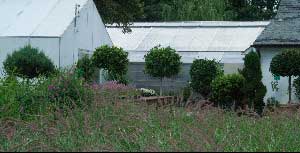
|
There are lots of mundane activities involved in having a prize show garden, like compost heaps, cold frames, mud rooms, and the like, which competitive show-gardeners never think of talking about, let alone putting on display. However, someone who feels very competitive about the garden usually lets that competitiveness spill over into the greenhouse. Most working greenhouses are muddy and disreputable-looking. When you see a big greenhouse with a spotless floor, however, you know you are learning something about the owner. When tidiness extends to spotless tools and well-sharpened pencils, there's a message. This greenhouse is not merely a tool shed, it's part of the display.
Let's talk about three outstanding greenhouses in the Philadelphia region which are adjuncts to three outstanding horticultural competitors. To spare the feelings of all concerned, the names of the owners will not be mentioned. In one case, the plants are preponderantly indoor plants, a second one is preponderantly filled with outdoor plants, and the third is full of rarities.
The greenhouse full of indoor plants reflects an owner who primarily competes in flower shows in that type of plant, it is true. But this lady obviously brings the flowers to a peak of perfection and then shifts them into the house. The result is a dining area with twenty-five potted flowers scattered tastefully around, dressing up the house. One presumes the flower pots go back to the greenhouse when they start to wilt a little, and probably an effort is made to have plants which flower at different seasons of the year. Back out in the greenhouse, there are dozens of blue ribbons arranged within picture frames to produce pleasing arrangements in themselves. Although this is a famous horticulturalist of long standing, the blue ribbons on display are only awards from fairly recent shows.

|
The second greenhouse to be mentioned is primarily devoted to outdoor plants, being bred and hybridized in controlled circumstances. The owner has created a garden in the interior of a suburban block on the Main Line, and although the houses are all part of the estate, the effect is one of the certain types of plantings in several backyards, a set of sculpted topiaries in one, a formal arrangement of boxwood designs in another, annuals in another. Although the rotation of plantings back and forth from the greenhouse is here probably more of a one-way trip, essentially the greenhouse is serving the same function as the one servicing the indoor display, a place to nurture plantings which are not quite ready for prime time.

|
And the third greenhouse is primarily run by a husband and wife team of horticultural competitors. The other two gardens look as though they employed a dozen or so gardeners, while this one looks like it supports a two-person hobby. It contains a most unusual fern with its own nickname, and dozens of other display specimens of rare and unusual plants to compete in specialty shows of particular varieties. This greenhouse is just as spotless as the ones with much larger staff to do the cleaning, but it seems to have a wider variety of gardener conveniences to lighten the load and increase productivity. One quickly senses that the husband of the team pores over greenhouse catalogs and quickly adopts labor-saving devices. Space is at a premium in this greenhouse, and one guesses its results as much from a need to conserve steps as to conserve space. The effect faintly starts to resemble the jam-packed cockpit of a space-ship.
One technology advance seems to be so superior they all have it. The exterior surface of the greenhouses is not made of glass, but of polycarbonate plastic, sometimes known as "bullet-proof glass". Greenhouses seem a safe enough use for polycarbonate, although widespread use in disposable plastic water bottles seems a more questionable direction for environmental enthusiasm. This transparent material admits the light of a much wider wavelength, particularly ultra-violet, and no doubt greatly extends the season and the effectiveness of indoor nurture. From the photographer's point of view, the resulting pictures are far more pleasing, with diffused light and greater color brilliance. Thus, science has finally achieved for the Philadelphia region the same striking color of light that was so attractive to French Impressionists in southern France, and to vacationers in Hawaii.
The other thing this plastic invention has done has been to increase the general attractiveness of greenhouses. Until rather recently, it was the custom to paint white-wash on the glass and let it slowly weather away as increased sunlight is needed for the plants. Thus, greenhouses once almost always looked shabby and disreputable; not a place you would want seeing by visitors. But nowadays, you just keep them spic and span. And hold a cocktail party there.
REFERENCES
| Standardized Plant Names: American Joint Committee on Horticultural, Frederick Law Olmsted | Google Books |
Serpentine Rock From Serpentine Barrens
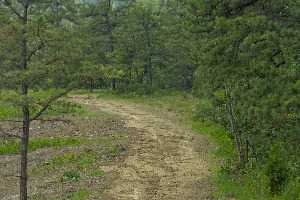
|
| Barrens |
Even in pre-revolutionary Colonial days, it was recognized that patchy areas of Chester and Lancaster counties were covered with twenty-foot stunted evergreens instead of two-hundred-foot oaks. They were "barrens", resembling the pine barrens of central New Jersey. In time, these barrens were particularized as Serpentine barrens, out of a recognition that this stunting of vegetation was somehow associated with greenish stone in the bedrock. So, the serpentine barrens in time became serpentine rock quarries, but they seem somehow less barren now that surrounding deciduous forests have been cut down to make nice farmland. The greenish stone was a novelty, especially because it was usually (but not invariably) soft sandstone and easy to quarry, and the bedrock was only an inch or so under the topsoil, or even appeared on the ground surface as outcropping. These qualities made serpentine a popular building material, but in retrospect, it should have been more apparent that sandstone crumbles easily, and what can stunt tree growth probably wasn't very good for you.
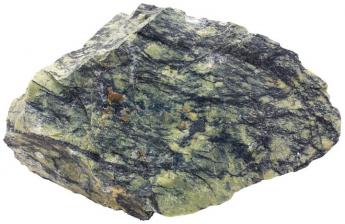
|
| Serpentine Rock |
Well, the green color comes from chromium salts. Sometimes the greenish color is diffused throughout the volcanic rock, but more commonly concentrated in green veins "snaking" through sandstone. Diffuse is better for building because the greenish intrusions create fracture lines in response to acid rain. In modern times, we mostly think of chromium as imparting a shiny look to plated auto bumpers. Some automaker was once quoted as saying he sold more cars using $10 worth of chrome than with $100 worth of engineering. That's metallic chrome because central to the definition of a metal is that it looks shiny. Even high school chemistry scholars can tell you it is a "salt" of chromium, the chromic ion, which imparts a greenish tinge when dissolved in water. So, chromic salts dissolved in the local water are what dwarf the vegetation of a serpentine barren, not chromate (which is yellow), and not metallic chromium (as in auto trim). So, although one might suppose otherwise, a few years ago when local builders started up modern quarries of the serpentine rock, the environmentalists of Chester County were up in arms. Demonstrations were held, editorials are written, politicians hectored. The Serpentine Barrens was a local treasure, requiring legal protection; protective ordinances were demanded.

|
| Building construction with Serpentine Rock |
Although building construction with the serpentine rock had a considerable flurry in the late 19th Century, the crumbly nature of sandstone caused the disappearance of all but a few examples. A building in boathouse row on the Schuylkill, a pre-revolutionary house on the Brandywine battlefield, College Hall on the campus of the University of Pennsylvania, pretty much comprise the notable surviving examples. But in a certain way, the Serpentine buildings do sort of define Victorian Philadelphia.
California is not within the intended scope of Philadelphia Reflections. However, it probably should be mentioned that Serpentinite is the official California rock, as would be natural for a substance which composes about 2000 square miles of its bedrock. It's green in color, but has high magnesium content, and seems to originate with the grinding of tectonic plates as they throw up mountain ranges, with attendant earthquakes. California also has serpentine barrens, but local geologists blame that harmful vegetation effect on magnesium competing with soil calcium (rather than the less notable chromic ions in West Coast serpentine). We're getting into some pretty fine distinctions, here. Pennsylvanians will probably be content to know we found ours first, that it had a flurry in Victorian architecture, and it's just a bit quaint. And, that it doesn't pose a significant risk for asbestos poisoning. A California geologist, in defending their state rock honor, recently proclaimed there was a greater statistical risk of dying from their state animal (the grizzly bear) than from their state rock.
REFERENCES
| The Pine Barrens: John McPhee: ISBN-13: 978-0374514426 | Amazon |
Green Roof at Peco
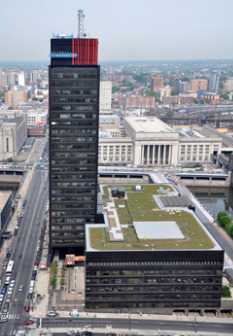
|
| PECO Building |
The Horticulture Society, the Hort to locals, recently conducted a tour of the green roof which Philadelphia Electric, now Exelon has put on the top of that big black building across the street from 30th Street Station. It's a large flat roof, and the ten varieties of sedum are quite handsome.
It's a public service activity, however, designed to help the environmental movement get up some momentum. When you look out at the Philadelphia landscape from the top of a skyscraper, it's possible to see a whole new dimension to the city. On its top, Philadelphia is one huge sea of roofs. If all of those roofs were planted, it would indeed make a huge difference of some sort. Unfortunately, the vast majority of those roofs are residential, slant-roofed, and small.
The Peco roof involved a considerable amount of tailor-made work which would have to be streamlined to make it practical for residences. First, a waterproof liner is put down, then layers of artificial plastic dirt on cushioning layers. Then the plant layer is unrolled, filled with seeds and sprouts of ten different varieties of sedum. Over time, Darwinism takes over, to make the most suitable variety of sedum thrive in the areas most advantageous to it, probably with some judicious watering to get it all started. The result is to reduce the roof temperature in summer from around 160 degrees to 70 degrees, with a consequent reduction in air conditioning costs. It does look rather pretty.
But then some hard facts of economics enter into the discussion. The roof is thought to last fifty years instead of the usual twenty since most deterioration is due to sunlight. Most homeowners don't last fifty years, however, and in fact, the average duration of ownership is around seven years. Most homeowners are skeptical they could pass on the cost to the next owner, and therefore are dubious of promised savings. Churches, museums and public buildings are therefore the most likely market in the early going. The Quakers, as usual, were the first adopters, for their administrative center at fifteenth and Cherry.
And then, there is the height of the building, which is sort of a catch-22. The taller the building, the smaller the proportion of cost savings to the owner; for the most part, the lower stories of a skyscraper are unaffected by what's on the roof. So, office buildings are unlikely to take up the green roof revolution first, or for strictly economic reasons. That leaves mostly residential roofs, which are mostly slanted in this town; the Bauhaus movement hasn't caught on much in this country. It has made more progress in Germany, and Tel Aviv is said to be predominantly Bauhaus. Consequently, we hear tales of these cities getting ahead of us, but it figures. It will be a long time before what Weir Mitchell called The Red City gets rebuilt in a flat-roof style. The proponents feel that green roofs can be adapted to slant-roof structures, but the objections to snow and rain accumulations are obvious obstacles to a city-wide transformation which would even so take a very long time.
There's even a problem with birds, who tend to drop weed seeds where ever they roost. Crabgrass, for example, is an annual which dies each year. Not everybody is willing to devote time every summer to pulling crabgrass off the roof. So, here's another advantage for skyscrapers, which is to say a disadvantage for houses. And some financial wizardry has got to be devised to pass the green roof investment of thousands of houses on to the next, skeptical, owners. And inventors and tinkerers have got to find a thousand little ways to make this process cheaper; at present, it takes too many different tradesmen and artisans to put it all together. In short, it probably costs too much at present to hope to be popular.
Our reaction here is generally favorable to the idea but skeptical of the economics. Except for altruists, idealists, and experimenters. It would seem very fine if more people took it up and perfected it. Meanwhile, it may really not be "ready", as the Quaker says.
Powel House, Huzzah!
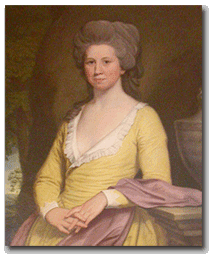
|
| Elizabeth Powel |
If George Washington were still alive he would no doubt be a Republican, but the term Republican Court actually has nothing to do with R's and D's. It was a scheme deliberately cooked up by Washington and Madison to enlist support by the new government's important ladies for a modified version of a European royal court, to make thirteen colonies into a cohesive nation. A most remarkable thing about it was its frank imitation of the royal courts, something only the Father of His Country could pull off in former colonies which had just fought an eight-year war to be rid of the monarchy. It is one more great testimony to the faith of Americans in George Washington; but it also testifies to the power of enthusiastic women, once they agree on a project. Chief among the leaders in this court was Elizabeth Powel, along with her niece living around the corner on Spruce Street, Anne Willing Bingham. Recently, the Peale Society of the Academy of Fine Arts held a candlelight dinner in Mrs. Powel's magnificent second-floor dining room, while scholars of the history of the Republican Court told assembled notables of Philadelphia what had once been what, during the first ten years of the Republic.
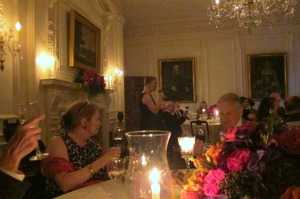
|
| Dining Room |
Members of the early Congress were largely the same men as the founding fathers of the Constitutional Convention, hand-picked by Washington and Madison to persuade the legislatures of their colonial states to give up state sovereignty, for a unified nation. There was the difference that now they brought their wives to live in Philadelphia during sessions of Congress. Those women wanted to know each other and wanted to have something exciting to do together in the largest city in the nation. Their husbands knew well how politically useful it was to be socially acquainted in this way, so everybody liked the idea of suddenly becoming nationally connected. The initial idea proved unworkable. Martha Washington was supposed to become Lady Washington, reigning over weekly receptions.
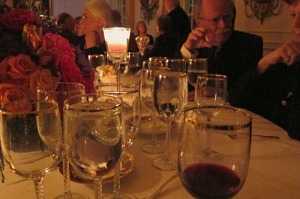
|
| In Our Cups |
But Martha, unfortunately, wasn't up to the task, and Anne Bingham whose rich husband had taken her on lengthy tours of European royal courts, moved right in and took charge of this project. Besides her cousin Elizabeth Powel, notable members of this social whirl were the two daughters of Chief Justice Benjamin Chew, Alexander Hamilton's wife, and various members of the Shippen and Willing families. Members of the family of Lord Sterling of New Jersey, Charles Carroll of Carrolton, Maryland, Cadwaladers of various sorts, and a number of other names famous from then until even today joined their affiliations with ladies from other states through parties and even some weddings. John Adams was particularly awestruck by the poise and beauty of Anne Bingham, although Abigail Adams may not have been quite so infatuated. It was a dizzy whirl, with dinner parties the central activity just as they are in Philadelphia even today. Country bumpkins had to learn how to dress, to talk and to eat with the right spoon and keep their elbows off the table; those who could tactfully show them what was what were friends for life. Centuries later, Emily Post made a fortune writing books about these rules.
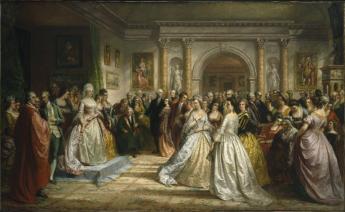
|
| Republican Court |
In those days, they even had their war cry, which was to raise a glass and shout back "Huzzah" in response to the proposer of a toast, who had raised his glass starting the warcry. It wasn't "Skol" or "Cheers" or "Here, here" if you knew what was what; it was "Huzzah". Most fashionable dinners had at least twenty courses, but the ladies didn't eat them. It was a whispered instruction among the ladies that they should eat before the dinner, so they could gracefully decline to gobble up goodies, and spend their time in gay conversation or waiting to be asked to dance. Drinking and eating, especially drinking, was for the men at the party, although naturally the many courses of the banquet were put in front of the ladies to be airily ignored. When George Washington was present as he often was, or even La Rochfoucault himself, it was important to remember every spoken word.
And, you know, it worked. When these important people went back home, they took the customs of the Republican Court with them. The American diplomatic corps found the equivalent of minor-league training for their efforts on behalf of the country abroad. Politics was easier if you personally knew your adversaries as well as your allies. The persistence of the same family names in the Social Register, the lists of The Four Hundred and other compilations of high society show that Anne Bingham and Elizabeth Powel did indeed know what they were doing, and for that matter, so did George Washington. If anyone else had been at the top of this heap, Thomas Jefferson stood ready to attack with all his might.
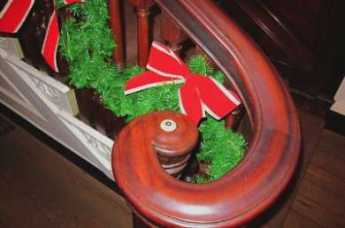
|
| Amity Button |
But he and even Patrick Henry didn't dare attack Washington. The aristocrats of Old Europe probably did sneer at this amateur effort, and in some circles still, do. But the inability of absolutely any other group of nations, whether European, Asian or South American, to unite peacefully is a thumb in the eye of anyone who mocks George Washington's little Philadelphia creation. And to think it all began right here, right here in the Powel House, right here in the dining room on the second floor. For that, folks, one thunderous "Huzzah!"
REFERENCES
| A Portrait of Elizabeth Willing Powell: 1743-1830 David W. Maxey ISBN-13: 978-0871699640 | Amazon |
Heavenly House
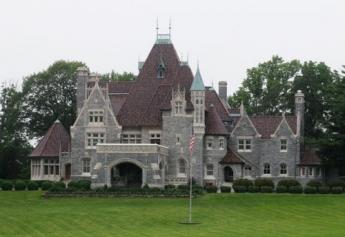
|
| Father Divine House |
While prosperous people, on deciding to enter a retirement community, are often heard to say they are tired of managing a big house, it can also be noticed that people who get the foreign travel bug usually drift around to see the palaces, castles, and estates of kings and emperors. The king's bathroom plumbing is a stop on most tours. Places like Buckingham Palace, the Vatican, the Temples of Karnak, Fortresses of Mogul Conquerors of India, or similar places in Cambodia, are all vast looming piles of stone dedicated to the memory of departed leaders who Had it All. That's probably all you need know, to understand that Americans who have it all tend to build huge show places, too. A great many do discover the castles to become just too much bother. Safe protection and privacy are somewhat separate issues, reasons given for putting up with a big place past the time the thrill has worn off. Perhaps such jaded feelings appear at the end of the wealth cycle. Nevertheless with enough affluence, if you had unlimited money and inclination, where around Philadelphia would you put a dream palace, one built for a modern Maharajah? Answer: close to Conshohocken.
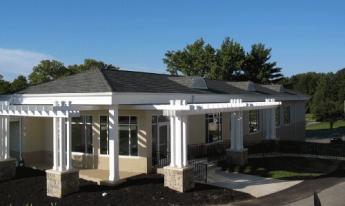
|
| The Philadelphia Country Club |
The Schuylkill takes a sharp bend at Conshohocken because it flows around a big cliff on the west side of the river. It was there the White Steel Company built the first wire suspension bridge in the world, as distinguished from cable (twisted wire) suspension bridges invented by Roebling at Trenton. The bridge was swept away by a flood, the steel mill replaced by the Alan J. Wood Steel Company. Alan Wood prospered mightily, and built his mansion ("Woodmont") on 75 acres on the top of the big rock on the west side of the Schuylkill, in such a way he could watch the smoke rising from his factory down below at the foot of the cliff. The Philadelphia Country Club is across the road from Alan Wood's mansion, with fairways clinging to the cliffs, a Gun Club for trap shooters who want to aim away from houses and toward mountainsides, and a cliff-top road leading straight for Gladwyne between dozens of mansions with five-acre lots. Down the hill, however, rocky projections force the road to funnel into a winding crooked road which ends up near the filling stations of Conshohocken, passing ancient farm structures on the way. Railroads and expressways tend to fill the valley, the old White bridge is gone, and two distinct cultures are within a few hundred oblivious yards of each other. To the west stretches the Main Line, now filled with houses almost as large as the mansion, but air-conditioned and filled with other modern amenities. Seventy acres of a lawn is nice, but it's a lot of grass to cut.
The Alan Wood Steel Company had a hard time in 1929, recovered somewhat after World War II, and then declined to the point where Lukens and Phoenix Steel took over. And then Indians from India took over the lot, forming part of the largest steel complex in the world, now headquartered abroad. In 1952, one of Father Divine's religious followers named John Devoute gave Father the Wood mansion; which then became the new headquarters of his religious sect. He died in 1965 but Mother Divine still lives there in stately and tasteful semi-seclusion. The grounds of the estate are beautifully tended by various of the twenty-five attendants of Mother. Father's mausoleum is near the house.
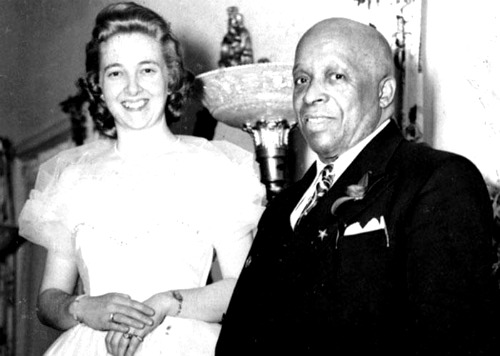
|
| Father and Mother Divine |
The house itself is patterned after Biltmore in Asheville, NC, although perhaps only a quarter as large. Just inside its portecachier, the oak-paneled living room has a ceiling 45 feet high, and many oriental rugs. There is a music room, off to the side of which is Father's former office, bearing a strong resemblance to the Oval Office in the White House in Washington. As planned, the living room window looks down the valley to the site of the old steel mills, although when the trees are leafed out it may be difficult to see. The dining table probably seats forty people, although the paneled dining room was fitted with electronics and used to broadcast sermons to religious adherents across the country. In the living room are testimonies to the many who seemed to rise from the dead, or who had their blinded sight restored, or who were crippled but enabled to walk. The attendants take visitors on tours, but Mother Divine likes to meet them, coming down the sweeping staircase without noticeably showing her age. The greeting of "Peace" replaces the usual "hello" and "goodbye".
At one time, the Religion housed a large number of single women in several hotels, and the invested proceeds of their work as domestics still supports the Religion. The religion frowned on gambling, drinking, smoking, and sex. However, celibacy inevitably leads to a decline of numbers, particularly evident since the death of the founder.
Ageing Owners, Ageing Property
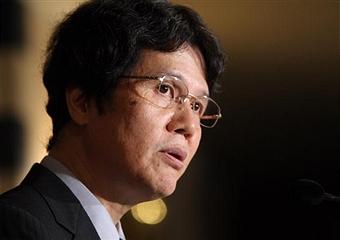
|
| Kiyohiko Nishimura |
Kiyohiko Nishimura is currently the Deputy Governor of the Bank of Japan (BOJ), and as such is expected to have wise things to say about finances, as indeed he does. Japan has a far older culture than the United States, and a botanical uniqueness growing out of the glaciers avoiding it, many thousands of years ago. But its latitude is approximately the same as ours, and its modern culture is affected by the deliberate effort of the Emperor to westernize the nation, following its "opening up" by our own Commodore Matthew Perry in 1852. Perhaps a more important relationship between the two cultures for present purposes is that Japan has been suffering from the current deep recession for fourteen years longer than we have. We don't want to repeat that performance, but we can certainly learn from it.
Mr. Nishimura lays great stress on the aging of the Japanese population because, in all nations, houses are mainly purchased by young newly-weds, and sold by that same generation years later as they prepare to retire. If a nation has an elderly population, it can expect a general lowering of house prices someday, reflecting too many sellers leaving the market at the same time. The buyers of those houses are competing with other young people, so the simultaneous bulges and dips of the population at later stages combine to have major effects on housing prices. At the moment, younger couples are having fewer children as a result of women postponing the first one. Nishimura goes on to reflect that something like the same is true of stocks and bonds, although at age levels five or ten years later. One implication is that retirement of our own World War II baby boom is about to depress American home prices, which will likely stay lower for 10-20 more years. Furthermore, our stock market will have a similar effect, stretching the depression out by as much as 5-15 years. The Japanese stock market has been a gloomy place to be during the past fifteen years, and by these lights might continue in the doldrums for another five or so. Meanwhile, our own situation predicts an additional generation of struggle while Japan is recovering. It's best not to apply these ideas too closely, of course, but surely somebody in our government ought to dig around in the data, at least telling us why we ain't goin' to repeat this pattern. Please.
Perhaps because they eat so much rice and fish, the Japanese already have a longer life expectancy than Americans do, but in terms of outliving your assets, that's not wholly advantageous, the way a love of golf might be. The best our nation might be able to do is to examine some of our premises about housing construction. In Kyoto, most houses were built with paper walls, for example.
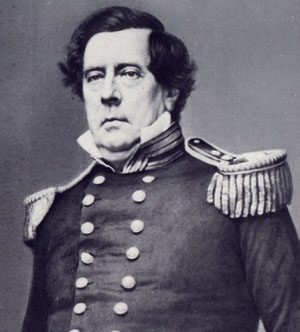
|
| Commodore Matthew Perry and Japan |
The house walls of the town of Kyoto were in fact made of waxed paper, which seems to work remarkably well. While no one now advocates going quite that far, we might think a second time about building the big hulking masonry houses so favored in our affluent suburbs. Such cumbersome building materials almost dictate custom building and strongly discourage mass production. How likely are such fortresses to survive in the real estate markets of fifty years from now? Judging from my home town, not too well. Haddonfield boasts it has been around since 1701, and there are at most three or four of its houses which have survived that long. We favor great hulking Victorian frame houses, with a good many bedrooms unoccupied, and high drafty ceilings, very large window openings and little original insulation. The heating arrangements have gone from fireplaces to coal furnaces, to oil, and lately to natural gas. The meter reader who checks my consumption every month tells me that almost all the houses now have gas heat, so almost all the houses are using their second or third heating plant, along with their eighth or tenth roof, and thirty coats of paint. This kind of maintenance is not prohibitively expensive, but just wait until the plumbing starts to go, and leak, and freeze, with attendant plastering, carpentry, and painting. Our schools and transportation are excellent, so we have location, location, location. But when the plumbing, heating, and roofing start to require financial infusions all at once, you get tear-downs. A tear-down is a new house in which a specialist builder buys the old house, tears it down, and looks for a buyer to commission the new house on an old plot of land. Right now, there appear to be six or eight such Haddonfield houses, torn down and looking for a buyer to commission a new house on that location, location. If we repeat the Japanese experience, there will be some unhappy people, somewhere. And that will include the neighbors like me, who generally do not relish languishing vacant lots next door, but fear what the new one will be like.
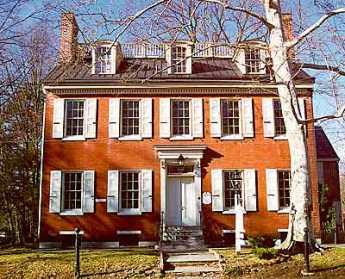
|
| Greenfield Hall |
The thought has to occur to somebody that building the whole town of less substantial materials in the first place would be worth investigation, replacing the houses every forty years when the major stuff wears out. At the present, when a town of several thousand houses has five or six tear-downs, the neighbors would not tolerate replacing tear-downs with insubstantial cardboard boxes. Seeing what has happened to inner-city school systems, the neighbors would be uneasy about "affordable housing" built in place of stately old Homes of Pride. In time, that might lead to a deterioration of one of the two pillars of location, location -- the schools -- and hence to a massive loss of asset value. And yet when those houses empty out the school children, leaving only retirees in place, the schools will not be worth much to the owners or in time to anybody else. There's an unfortunate tendency for local political control to migrate into the hands of local real estate brokers, so you had better be sure any bright new proposal is tightly buttressed with facts.
The only real hope for evolution in this obsolete system may lie in the schools of architecture, strengthened perhaps by some research grants. Countless World Fairs have displayed the proud products of their imaginative thinking, but mostly to no avail. Perhaps the ideas are not yet ripe, but since it would take more than a generation to create a useful demonstration project of whatever does become ripe for decision, let's start thinking about some innovative suburban designs, right now.
A Few Rooms of Your Own
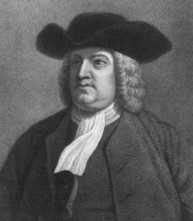
|
| William Penn |
If William Penn could revisit Philadelphia today, he would surely feel disappointed that the Greene Country Towne still hasn't materialized. Even a century after Penn's real visits, Philadelphia at the time of the Revolutionary War still nestled East of Fifth Street. There have been many conjectures about this, perhaps fear of Indian attack, perhaps lack of firewood, desire to be near the port, perhaps a number of things. Let's examine whether it's just the nature of a successful city to organize itself the way it does.
Ancient Athens, for example, was a nice warm place without much rain, which possibly accounts for the miserable little hovels where people lived, contrasting with the magnificent Acropolis, Parthenon, Stoa and other public buildings. It has been speculated that the architecture created the social system, not the other way around; the same contrast between big stone temples and little wooden huts is also seen in the Mayan cities of Yucatan. Hong Kong certainly isn't poor, but it's built like that. Japan cannot claim that lack of land forces the citizens to live in tiny apartments. It's hard to say whether the lowly social state of Japanese women accounts for the contrast between where they live and where their husbands spend most of their time because it's just as easy to believe the proposed cause is really an effect.
The more you look around the world, the more you wonder if it isn't the American suburb that's out of step with the world. When they can afford it, hardly any of the world seems to want to live in the suburbs; their homes are seldom their castles. There's New York City, of course. New Yorkers seem to like living in high-rises.
An architect friend makes short work of construction economics as a driving feature. According to him, it is unduly expensive to live in a high-rise. Just a pointless ego trip. The cost per square foot of usable floor space just keeps going up as the building gets taller, requiring more elevator shafts, more elaborate HVAC. That's heating, ventilating and air conditioning. Everything has to be built with a derrick, the traffic congestion at the base is horrific, high winds can break the window glass. The list rapidly grows convincing. Why does anyone pay all that extra money to live high in the sky? Not my idea of something to do, says Cole Porter.
Notice there is a major difference between sleeping in the suburbs as they do in Japan, and sleeping in apartments right near the center of town, as they do in Budapest, Berlin, Prague, and Vienna. The Orientals are staying close to work for longer hours, while the Central Europeans are staying close to the cafes and theaters to which they flock the moment work is over. Just what to think of the Spanish siesta system isn't clear, but it seems to have the main effect of bringing people back into the center of the town at night. You can't live very far away from work if you have to commute twice a day.
The Lord only knows where everybody in New York is going every Friday night, with return traffic jams in the other direction on Sunday night. The weekly exodus suggests they don't really luxuriate in their penthouses or flock to their entertainment district on weekends; apparently, a cabin in the woods is beckoning. As, by contrast, the empty nesters in the suburbs eventually look around for retirement villages to live, repeating the endless complaint about the nuisance of maintaining a big house and garden. Pennsbury looks like a comfortable place to live, but even William Penn seems to have tired of it. One really does have to wonder whether a heart's desire in architecture all too frequently leads to heart's discontent in lifestyle. Philadelphia appears to be trying a new approach; the suburbs are moving back downtown.
We'll eventually see if it changes our character and lifestyle so somebody can write sociology books about it.
Relocation

|
| Moving Truck |
For many decades, at least since the Second World War, the Northeastern part of the country has been losing population. And business, and wealth. In recent years, New Jersey has been the state with the greatest net loss, and the Governor who is making the greatest fuss about it. Statisticians have raised this observation to the level of proven fact, although lots of people are even moving into New Jersey at the same time. This is a net figure, and it remains debatable what sort of person you would want to gain, hate to lose; so it's hard for politicians to be certain whether New Jersey's demographic shifts are currently a good thing or a bad thing.
Take the prison population, for example. Most people in New Jersey would think it was a good thing if the felons all moved to some other state because it would imply less crime and law enforcement costs. But one of the major recent causes of a decline in violent crime seems to be the universal presence of a portable telephone in everyone's pocket. Just let someone yell, "Stick 'em up!" loud enough, and thirty cell phones are apt to emerge, all dialing 911. On the other hand, cell phones are the universal communication vehicle for sales of illicit drugs and other illegal recreations, and the increase in automobile accidents is a serious business for inattentive drivers. Add to this confusion the data that capital punishment is more expensive for the State than incarceration is, and you start to see the near futility of knowing what is best to have more, or less, of.
What the Governor and his Department of Treasury mostly want to know is whether certain taxes end up producing a good net revenue for the State. That is, whether more revenue is produced by raising certain taxes more than others, or whether some taxes are a big component of the Laffer Curve, causing revenue to be lost by driving business, or business owners, out of state, in spite of the immediate revenue gain. The studies which have been done are fairly conclusive that executives tend to be most outraged by property taxes, since they have a hidden effect on the sale price of the house, and the amount of money available for school improvements. At least at present levels, a Governor is better off taking abuse for raising income or sales taxes, even though the apparent tax revenue might be the same as a rise in property taxes. Since property taxes are mostly set by a local municipal government, while sales and income taxes are usually set by state governments, a decision to raise one sort of tax or another can have unexpected consequences, or require obscure manipulations to accomplish.
Some politicians who believe their voting strength does not lie in the middle class, would normally want to hold up property values, not taxes because the data show that higher home prices drive away from the middle class and in certain circumstances are positively attractive to wealthy ones. Higher prices appeal to home sellers, at least up to a point. Wealthier people who are buying houses are likely to have an old one to sell; that's less true of first-time home buyers or people presently renting. Certain issues can even be reduced to rough formulas: a 1% increase in income tax would cause a 1% loss of population, but a 5% loss of people earning more than $125,000. A $10,000 increase in average home prices, on the other hand, causes a net loss of population, but mostly those with lower income. One important feature of tinkering with average home prices and property taxes is that these effects are "durable" -- they do not fade away over time.

|
| Laffer Curve |
New Jersey is financially a bad state to die in, but the decision to move to Delaware, Florida or Texas is often made over a long period of years in advance of actually doing it. It has been hard to compile statistics relating changes in inheritance tax law to net migration of retirees and to present such dry data in an effective manner to counteract the grumblings that rich people are undeserving of tax relief, or dead people are unable to complain. But rich old folks are very likely to own or control businesses, and if you drive them out of state, you may drive away a considerably larger amount of taxation relating to the business in other ways. This is the underlying complaint of Unions about Jobs, Jobs, Jobs; but state revenue also relates to sales taxes of the business, business taxes, employee taxes, real estate taxes on the business property, etc, etc. Sometimes these effects are more noticeable in the region they affect; the huge population growth of the Lehigh Valley in recent years is mainly composed of former New Jersey suburbanites, who formerly earned their income in New York. The taxes of three different states interact, in places like that.
The audience of a group I recently attended contained a great many people who make a living trying to persuade businesses to move into one of the three Quaker states of the Delaware Valley. The side-bar badinage of these people tended to agree that many of the decisions to relocate a business are based on seemingly capricious thinking. The decision to consider relocation to the Delaware Valley is often prompted by such things as the wife of an executive having gone to school on the Main Line. Following that, the professional persuaders move in with data about tax rates, average home prices, and the ranking of local school quality by analysts. Having compiled a short list of places to consider by this process, it all seemingly comes back to the same capriciousness. The wife of the C.E.O. had a roommate at college who still lives in the area. And she says the Philadelphia Flower Show is the best there is. So, fourteen thousand employees soon get a letter, telling them we are going to move.
And, the poor Governor is left out of the real decision-making entirely, except to the degree he recognizes that home property taxes have the largest provable effect on personal relocation. And lowering the corporate income tax has the biggest demonstrable effect on moving businesses. But the largest un-provable effect is dependent on the comparative level of the state's inheritance tax.
Peggy Shippen and Benedict Arnold: Fallen Idols
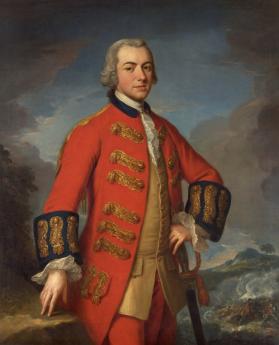
|
| General Burgoyne |
After defeating Washington's troops at the battle of Germantown, the British then occupied Philadelphia for the better part of a year. The town was a mess, with food shortages typical of the squalor of any occupying army equalling the existing population. Washington was forced to fall back to the natural fortress of Valley Forge. The city of Philadelphia was not exactly under siege, but it was as difficult a place for British troops to live as a besieged city. For his part, Washington was forced to shiver and starve in the nearby mountain valley, at least consoled by distant news of American achievements. General Burgoyne and his army were soon captured at Saratoga by General Gates under humiliating circumstances. Clearly, the dashing hero of this event had been Benedict Arnold on a white horse leading the charge, getting wounded in the leg in the process.
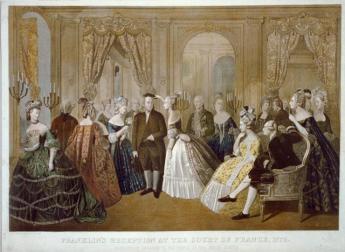
|
| Benjamin Franklin in Paris |
Benjamin Franklin in Paris trumpeted the news of this victory, reminding the French of Washington's earlier victory at Trenton, and maneuvering it all into a treaty of alliance. With the French fleet in the nearby Caribbean, Philadelphia was no longer a safe place for the British to stay a hundred miles upriver, and the idea of abandoning occupied Philadelphia began to grow. Having gambled on British victory in defiance of London's orders, the Howe brothers were not in a position to argue with new orders. The British soldiers inside the city were more comfortably housed than the American troops outside it, but nobody was exactly comfortable. The American Congress had, of course, fled to the hinterlands. All in all, it suddenly became uncertain who was going to win this war.
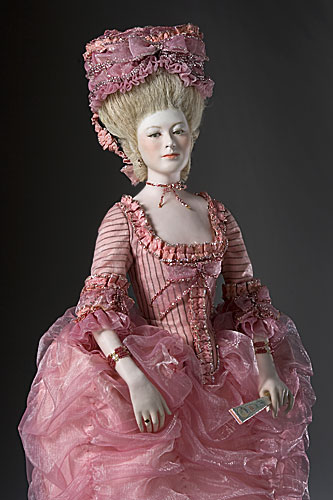
|
| Peggy Shippen |
The American population at this time has been described as a one-third rebel, one-third Tory, and one-third trying to hunker down to see who would win. Many of the seriously committed Tories had fled from Philadelphia when the rebels took charge, while pacifist Quakers were a little hard to classify. Generally speaking, the prosperous merchant class had never been persuaded King George was all that bad, while the less prosperous artisans were the fervent patriots. Under such conditions, many people who privately leaned in either direction found it was best to seem non-committal. The British were billeted in private homes; the Officers in the best houses of the merchant class, the common soldiers generally housed in the homes of the artisans. Although the soldiers and the artisans did not mix very well, circumstances permitted the aristocratic officers getting on pretty well with the merchants whose houses they occupied. The girls in the colonial families seemed immediately attractive to the British officers, who were far from home, while the officers also seemed pretty glamorous to the girls. So, it is not exactly surprising that the most beautiful colonial belles like Peggy Shippen and Peggy Chew found themselves frequently in company with dashing officers like Major John Andre. Andre would likely have been a heartthrob in any circumstance since he had risen to the rank of adjutant-general at a young age, wrote poetry and plays, reputedly was rich, and was regularly the life of any party. Nor is it surprising that generations of Peggy's descendants have treasured a lock of his hair.

|
| Margaret Oswald Chew Howard |
When the decision was finally made to abandon Philadelphia, six of the British officers personally contributed twenty-five thousand dollars to throwing Philadelphia's most famous, most splendiferous party, called The Machianza. It went on for days, had real jousting matches between officers dressed like knights in armor, banquets and all that sort of thing. It was Andre's idea, and he was enthusiastically in charge. Surviving records of the event do not show that Peggy Shippen was present, but in view of what happened later, much of her correspondence has been destroyed. It's pretty hard to imagine she wasn't there.

|
| Major General Benedict Arnold |
The British then marched away, and Washington's troops cautiously followed, assuming control of the city. Major General Benedict Arnold had been sent from Saratoga to Valley Forge to recover from his leg wound, and probably also to raise morale among the troops celebrating the now-famous hero. Washington more or less immediately decided to pursue the British across New Jersey, thus leading to the battle of Monmouth as the two armies raced for the Naval vessels in lower New York harbor. Since General Arnold had not fully recovered from his wounds, he was installed as the military governor of a somewhat bedraggled Philadelphia. Naturally, he was the center of the social scene, and soon was pursuing Peggy Shippen in every way he knew, which included some pretty gloppy letters in Romantic style. Peggy's father was uneasy about his intentions but was eventually mollified by Arnold's purchase of the house called Mount Pleasant, now a tourist attraction in Fairmount Park. With this evidence that his prospective son in law was at least likely to stay in Philadelphia, Edward Shippen finally repented of his opposition to the marriage of his daughter. But the new couple were soon off to West Point, where Arnold had kept up a persuasion campaign with George Washington, to get himself appointed the commandant of the main northern defense of the Hudson River. A point for Philadelphian tour guides to remember is that Peggy and Benedict never got a chance to live in Mount Pleasant.
Arnold originally lived in New Haven, Connecticut, where he had established quite a sea-faring reputation as a merchant, some would say privateer, others would say buccaneer. There is no doubt he was aggressive, and combative, and considered himself a little bit above the law. These qualities made him outstanding at Fort Ticonderoga and Saratoga, and are always more highly valued in young men in a war. Unfortunately, he made a bitter enemy of Joseph Read who was briefly his neighbor, and later was President of the Continental Congress. Read accused Arnold of smuggling and trading with the enemy, and was so determined about it that Arnold was scheduled for court-martial, but postponed. Arnold was loudly defensive about the whole matter, and public sympathy was on his side. In view of what soon happened, he might well have been cleared by the court, but likely there was some truth to the accusations. Using Peggy as a go-between, he entered into a correspondence with Andre (then the adjutant-general in New York) offering to deliver the surrender of West Point, three thousand prisoners, and possibly George Washington himself in return for what might today be half a million dollars. As a note of realism, he was willing to accept half that in the event of failure. The British were particularly anxious to acquire American prisoners to exchange for their own troops captured at Saratoga. Unless Arnold was a total sociopath, he must have thought he had quite a grievance.
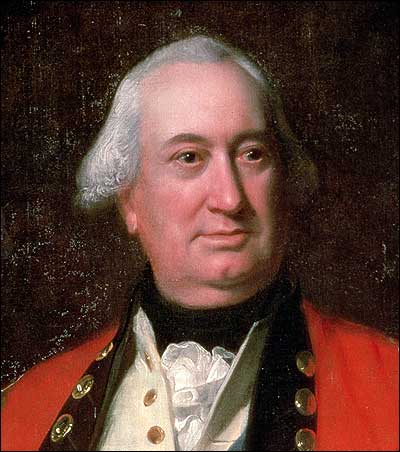
|
| Lord Cornwallis |
Things went along surprisingly well at first, with negotiations for price back and forth, plans for attacking West Point moving along with the Navy, and Andre disguising himself for a visit to Arnold in his house to the south of the Fort on West Point. Much of the success was due to the movie-star reputation of Benedict Arnold; few could imagine such a hero doing such an unheard-of thing. However, the plot was discovered while Washington was away visiting the Fort, and Arnold hastily abandoned his family and fled to a waiting British warship. Andre decided to make his way south to the ship through rebel territory, but local soldiers and farmers were much more suspicious than others had been, and after penetrating his disguise, found incriminating papers concealed in his boots. Since he was out of uniform behind enemy lines, Andre was by definition a spy, which required hanging. He made a plea to be shot like a gentleman, but Washington with tears allegedly in his eyes refused. With much bravado, Andre jumped atop his own casket and placed the noose around his own neck, a behavior much admired by his compatriots when they heard of it
Meanwhile, Peggy had put on a crazy-woman act which apparently convinced Washington to be lenient, and allow her to rejoin her husband. The couple stayed in New York for a few months, toying with commands of loyalist troops in the south, but eventually taking ship for England. Lord Cornwallis was on the same ship and they became pals as shipmates, pleasing Arnold quite a lot. Unfortunately, British society was only stiffly polite to them, and many did not trouble to conceal their disdain for traitors to any cause, and thus life in England was not smooth. By that time, it is possible that many had begun to suspect the whole idea of treason was Peggy's idea from the start, as is today the conventional view of it. As an American aristocrat, she was uncomfortable with the rebels in Philadelphia, and as the impetuous wife of an accused smuggler, it was difficult to fit in with either the Quakers or the merchants with loyalist leanings. No doubt she heard some catty whisperings among her friends and relatives about her other romantic associations. The British paid them their promised pensions, but a career in the British Army was out of the question for her husband. But the real shock would come, from discovering the British as a whole didn't much care for their behavior, either.
Proposal for the Parkway
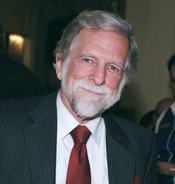
|
| Alvin Holm |
Architect Alvin Holm spoke recently about an idea he had dreamed up in 1986, for an amphitheater in the Eakins Oval, right in the middle of the Benjamin Franklin Parkway. At that time he envisioned it as a memorial to Grace Kelly, but Monaco wasn't interested, and the City was broke. But times change, neighborhoods change, and maybe the idea needs to be re-examined.
A bit of history needs to be refreshed. Around 1900 when the Parkway was dreamed up, Philadelphia was said by some local boosters to be the richest city in the world. That may have been a little overoptimistic, but it was nearly true enough that no one laughed loudly when it was enunciated. The Parkway was envisioned as a new departure to transform the whole city from square blocks of red-brick buildings of Georgian style, into a classical French version of grand elegance. To emphasize the new departure, it cut a diagonal from City Hall to the Art Museum, uniting these two French architectural monuments into a transformational classic boulevard. It wasn't just an imitation of Champs Elysees, it was a design by the very same architects, intended to lead the centers of many great cities of the world into modernized versions of the Roman Forum. Paris somehow managed to get away with it in time, but the 1929 crash stopped Philadelphia's dreams dead in their tracks, and the city just didn't recover.
Consequently, vast stretches of North and West Philadelphia were abandoned, then transformed into slums as poor people sought cheap housing. If you just look at Baltimore and Newark, you can easily see how sudden reversals can destroy a city completely. Philadelphia retreated into Center City, surrounded by an inner ring of slums, which were in turn surrounded by a ring of newer suburbs. The automobile hastened the flight to the suburbs, while the business district retreated to the inner core of Center City. In order to protect the Shining City on a Hill from being completely disrupted, informal barriers were sought, and the Parkway became one of them. They weren't walled moats, but they served the same purpose. Therefore, during the long decades of limping along, occasional cries of, "Why don't we make the Parkway into a grand boulevard?" had a silent, sullen answer. We weren't really sure it was a good idea. It didn't fit within our revised circumstances.
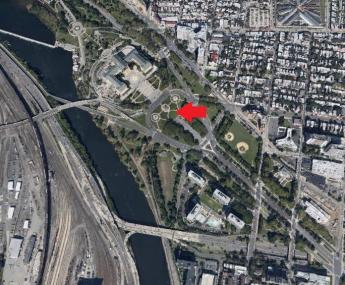
|
| The Amphitheatre on the Parkway |
But the City is now getting back on its feet, as anyone who has noticed the astonishing restaurant revival of Fairmount Avenue, or of Old Towne, or Society Hill, and the rebuilt "Chinese Wall" leading to and from the old Broad Street Pennsylvania Railroad station, can easily see. The Independence Mall and the University of Pennsylvania areas were largely built with Federal Money, but no matter, the transformation is still evident, the tide has turned. So Alvin Holm got out his drawings about premature dreams we couldn't afford, and asked, "Is it time?"
The unfinished Ben Franklin Parkway has cut its path, willy-nilly, through the neighborhoods, the trees have had time to grow, the museums time to migrate. The childless couples of the metropolitan area were coming back in town to enjoy the restaurant revolution and the theater revolution. Alvin Holm was getting a little older but not less energetic. He remembered that at the foot of the Art Museum was a statue of George Washington on a horse, and behind our First President was a big expanse of empty land. To build an amphitheater only took bulldozers, and could seat a thousand people. If you were as lucky as the ancient Greeks, and possibly if you built in precisely the same way, a speaker in the center could be heard -- without artificial amplification -- if he whispered, by everyone in the amphitheater audience. If you do use electronics, there's plenty of space in back of General Washington for a dignitary to give a speech on a raised platform, and there's enough empty audience space in a wider sweep, for fifty thousand people to congregate and listen. To him, or to a rock band, or whatnot. There aren't very many places left on earth in the center of a big city, where a single person can stand against a magnificent classical background, and be heard by fifty thousand chanting, hollering true believers. All of this could be accomplished by essentially digging a hole in the ground and closing off the area to traffic. But oh, yes, it takes one more thing. You have to want to do it. So let's consider for a moment who else covers the neighborhood, waiting for the right time to make a move.
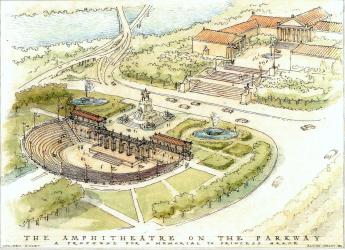
|
| Amphitheater Sketch |
Instead of regarding Fairmount Hill as just a big obstacle to automobiles trying to get home, let's just see what some others are thinking. For example, the people who run Drexel University are seriously talking about buying the air rights above the railroad marshaling yards on the west bank of the Schuylkill, and putting up a major business district and residential complex. They are thinking mainly of reviving West Philadelphia, and that's fine, but another bridge at that spot is badly needed to divert traffic around the present choke point on the Schuylkill Expressway, and that's also fine. Put some paths down to the river from the Art Museum to meet a new pathway to the Drexel development, as well as the recreational area along the river, and you could really have something pretty nice for the commuters who would otherwise begrudge the cost of digging an amphitheater hole in back of G. Washington.
Looking to the north of the Art Museum, there's a second small mountain with Kelly Drive between the two. At one time, both hills had reservoirs on top. The Art Museum demolished one reservoir, but the other reservoir is still there. It's a fifty-acre lake surrounded by dense forest; but from the inside look back over the top of the trees and you can see skyscrapers, almost right next to you. It's been adopted by migratory birds as part of the Atlantic flyway, and you would just be amazed at the hawks and ducks and all manner of other little black jobs that fly around and get recorded by bird watchers. The lake is full of fish, probably originally dropped by passing birds. The Audubon Society has a fundraising project going on, right now, to build a visitors' center in the forest, in conjunction with Outward Bound, the rock climbers group. Go to the left and you are overlooking the races at Boathouse Row, turn in the other direction to see Girard College, the hospital complex, and the further north you get to Temple University.
And one more thing. The old B&O Railroad once snaked along the Schuylkill and turned right around the (now) Art Museum, through tunnels over to Spring Garden Street, and down to Reading Terminal. Just what to do with this ditch running through the center of town unnoticed, is beyond my scope. Let someone else have a chance at being a visionary, but it must be remembered that New York City recently had a similar relic on its hands, and made something pretty nice out of the West Side of their town.
All of this potential even has the danger that projects will collide with each other, so it would sound like a nice idea for some Foundation to put together a planning board, to fit it all together without getting mixed up in politics, or squabbling over who will run things. But even that fuss would be a novelty, a nice thing to have for a while.
Glen Foerd, Torresdale, and the Feudal Industrial Style
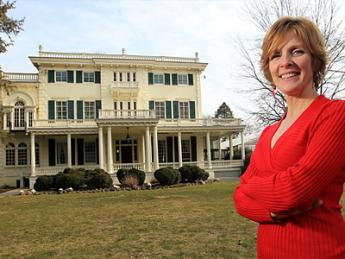
|
| Meg Sharp Walton |
Recently, the director of Glen Foerd on the Delaware, Meg Sharp Walton, told the Right Angle Club all about the mansion, the industrial titans who owned it, and the surrounding community which keeps it going. Glen Foerd Mansion sits on the small bluff where the Poquessing Creek enters Delaware. It's on the south bank of the creek, so it is just inside the Philadelphia boundary. Charles Macalester, who built the original mansion was a financier who sat on the board of the Second National Bank. So it is not surprising that he built a summer place just downriver from Nicholas Biddle's "Andalusia", which is on the north side of the creek. The Philadelphia consolidation of city and county government left one mansion in Philadelphia, and the other one in Bucks County. The region is perhaps better known for the little company town of Torresdale, and even better known for the Torresdale water inlet, where much of Philadelphia's water comes from Delaware. The Torresdale stop on SEPTA makes it an easy commute from Philadelphia, as does I-95, some of the time. The creek's inlet into Delaware is swampy, as most such confluences are, and is a favorite place for bird watchers and nature lovers. The tidal nature of Delaware at that point is quite apparent; at some times of the day, much of the bank of the inlet is bare ground.
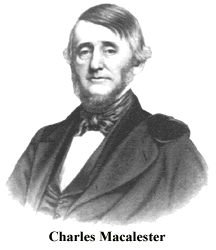
|
Charles Macalester may well have been the right sort, but he sold the property and left his estate to Macalester College in Minnesota, so Philadelphia doesn't find much to remember him by. After all, the early Quakers wouldn't even consent to put their names on tombstones, let alone name colleges after themselves. Robert Foerderer bought the property around 1850 and embarked on an elaborate renovation project. He had made his pile of money by purchasing the French patent for making kid leather and eventually had 5000 employees in Frankford making the material for kid gloves. The mansion on the river could be said to be the apex of an industrial empire, quite typical of how Philadelphia, particularly Northeast Philadelphia, did things. He was said to have been quite a benevolent emperor of this kid glove empire, including the little company town of Torresdale, until there was an industrial uproar of the 19th Century variety. Whereupon, he abruptly shut the whole business down, just as John Roebling did when his company town across the river wanted to run its own town. There's a sort of European flavor to this sort of story, sort of an opera about a principality on the Rhine River. This area of northeast Philadelphia and Bucks County has a number of principalities with this sort of town cohesiveness, where families who work there are clustered around their factory center, and children, and grandchildren, and great-grandchildren tend to stay in one place to live a life which ignores the rest of the world. Someone has to be the boss of such communities, tends to regard the position as hereditary, and definitely resents the idea that anyone else has much to say. Central to the concept is the Horatio Alger story of the hard-working youngster who gets to the top by merit, leading to the conviction that if someone else wants to be at the top of a heap, let him first build his own heap. Somehow, the Foerderer story seems to add realistic color to what was true about this social system.
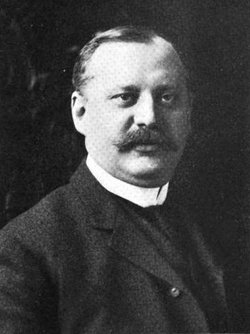
|
| Robert H. Foerderer |
Robert Foerderer died fairly young, having married Caroline Fischer, and producing a daughter, Florence Foerderer Tonner who married a New York hosiery tycoon named Tonner. The ornate decorations of Glen Foerd, the idiosyncratic taste in art, the parties and the ostentatious social circle, all add up to the sniffy description of "new" money, the so-called nouveau riche. The hundred older families of the Philadelphia establishment were very cautious about mixing socially with such newcomers and their often unexpected behavior, although there were notable exceptions. In all this uproar you can see the origins of the two present political parties, with the "old money" rich people displaying a quite surprising preference for redistributionist economics and environmental protectionism. It's easy to exaggerate, but a good part of this enduring split is due to social resistance of the older settler families to new ways of doing things, particularly when new ways have not demonstrated unequivocal value.
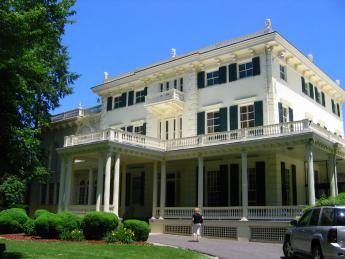
|
| Glen Foerd Mansion |
But returning to Glen Foerd, the name is a composite of the original Glengarry and the newer Foerderer. Florence Tonner got one of the first television sets to be produced and put it in the middle of her gallery of fine art. She sat there watching her favorite TV shows, why not. In her will, she left the estate to the Lutheran Church, but during the Depression, the church had trouble keeping it up. Someone discovered a clause in her will which provided, that in the event the Church could not support the estate, it was to be given to the residents of Torresdale. Since Torresdale only consisted of two streets, not including East Torresdale, West Torresdale, and any other splinter communities, the ownership of the estate was pretty closely held. This small group of true believers took up the burden and tried to make the estate survive. The house was opened to visitors, and available for weddings and events. Adult education courses, small-scale Chautauquas, bird-watching and nature walks were established. Slowly, the residents have been succeeding in making a go of it, but the original residents are getting older and dying off. It's going to be a hard struggle to make the place self-sustaining on every necessary level. But we wish them well, and certainly, admire their spirit.
Condominiums, Revisited
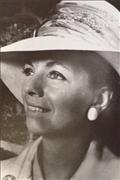
|
| Barbara Greenfield |
Barbara Greenfield died last year, and like her father was a real estate dealer. She was naturally all over town at one event or another, and at one such event, it was said she lived in a penthouse on Rittenhouse Square. I never saw her apartment, but it was part of the Greenfield lore that she lowered the floor and raised the ceiling, to make the place seem grander. Otherwise, this yellow-brick apartment building looked rather ordinary for a place built in 1928 by Horace Trumbauer himself. It was 28 stories high, and like the Racquet Club on 16th and Locust, it had the Trumbauer signature feature of an interior skeleton of massive steel beams, allegedly from the same source as the Benjamin Franklin Bridge, very solid, indeed.
Well, the Right Angle Club meets in the Racquet Club, so it was with considerable interest that we had two visitors, Melanie Rodbart and Jessica Senker, of guess what the J&M Preservation Studios, on the subject of 222 West Rittenhouse Square, one of their latest projects. It seems there were some cracks in the facade at the joins, and worse still, places where the brickwork bulged outward. Taking binoculars up a few floors in neighboring buildings, and getting lifted in the buckets of some cranes, it was possible to see there were indeed some repairs in the brick facade needed. Eventually, when the overlying bricks were removed, it was then possible to see corrosion on the steel beams had caused them to expand, so there was a need for much more expensive replacement of entire beams. Ouch, that's expensive indeed. At the very least, the sidewalks had to be closed while there was a danger of brickwork falling off to hit pedestrians below.
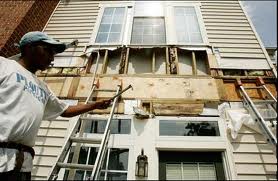
|
| condominium repairs |
There was a contractor sitting near me, so I asked him what he did about condominium repairs. The answer was prompt: he refused the business. It reminded me there was a time not so long ago when condominiums were illegal in Philadelphia, and it was contended this was considered an impediment to progress in the center of the city. As of course, it might well be, but how many condominium buyers anticipate the uproar which might result from arguments about paying for large shared expenses that are no one's particular fault? From what little I can see, all condominiums divide into two political parties: the half who want to spend money to fix the place up, and the half that can barely afford the payments on what they have. Add some lawyers to the mix, and it makes you wonder how wise it is to get into all that?
| Posted by: cheapoair | Feb 13, 2012 9:46 AM |
| Posted by: esalerugs.com | Feb 13, 2012 9:24 AM |
Barry
| Posted by: Barry | Apr 18, 2008 11:25 AM |
40 Blogs
The Nation's Capitol
 George Washington himself may have stated the vision of the Capitol building in the city named after him; Thomas Jefferson stated strong views. But the original building was designed by Bulfinch of Boston, rather like the Massachusetts General Hospital. After the War of 1812, a succession of Philadelphia Architects took over and made it what we know today. Benjamin Latrobe set things moving, then Thomas U. Walter reset the proportions under the influence of William Strickland. If Philadelphia was to lose the capital in a political deal, at least it could define the outcome.
George Washington himself may have stated the vision of the Capitol building in the city named after him; Thomas Jefferson stated strong views. But the original building was designed by Bulfinch of Boston, rather like the Massachusetts General Hospital. After the War of 1812, a succession of Philadelphia Architects took over and made it what we know today. Benjamin Latrobe set things moving, then Thomas U. Walter reset the proportions under the influence of William Strickland. If Philadelphia was to lose the capital in a political deal, at least it could define the outcome.
Friends of Boyd
 The last movie palace in Philadelphia is either ready for restoration, or the wrecking ball.
The last movie palace in Philadelphia is either ready for restoration, or the wrecking ball.
Venturi's Franklin Museum in Franklin Court
 For several decades there has been a splendid museum of Franklin's personal life, hidden within the famous block where he once lived. Children love it.
.
For several decades there has been a splendid museum of Franklin's personal life, hidden within the famous block where he once lived. Children love it.
.
Quaker Gray Turns Quaker Green
 Quakers mean to turn their headquarters near Philadelphia City Hall into a glowing example of how to save money while they save their environment.
Quakers mean to turn their headquarters near Philadelphia City Hall into a glowing example of how to save money while they save their environment.
Pennsbury Manor
 The Delaware River takes an abrupt right turn at Trenton, creating extensive wetlands for miles around. Whatever its environmental drawbacks, the river delta is moving toward landfill and "development". Come back in fifteen years and be amazed.
The Delaware River takes an abrupt right turn at Trenton, creating extensive wetlands for miles around. Whatever its environmental drawbacks, the river delta is moving toward landfill and "development". Come back in fifteen years and be amazed.
Wall Art in Philadelphia
 Several thousand Philadelphia buildings now display outdoor paintings by local artists, encouraged and funded by the City government. In the summer, bus trips with guides tour around the town, explaining things.
Several thousand Philadelphia buildings now display outdoor paintings by local artists, encouraged and funded by the City government. In the summer, bus trips with guides tour around the town, explaining things.
Unexpected Benefits of a Lurid Past
 The legal prohibition of liquor caused corruption of society which was worse, and lasted longer, than the problems it might have solved. Here and there, some surprising advantages lasted a long time, too.
The legal prohibition of liquor caused corruption of society which was worse, and lasted longer, than the problems it might have solved. Here and there, some surprising advantages lasted a long time, too.
Sacred Places at Risk
 Church structures don't migrate, but church members do. A volunteer organization in Philadelphia has formed, to help endangered congregations decide how to review their options and act on the best choice.
Church structures don't migrate, but church members do. A volunteer organization in Philadelphia has formed, to help endangered congregations decide how to review their options and act on the best choice.
The University Museum: Frozen in Concrete
 Archaeology has long been at the center of Philadelphia culture. The University Museum of Archaeology, the largest of its kind in America. is a victim of success, stranded in a congested and overbuilt corner of town.
Archaeology has long been at the center of Philadelphia culture. The University Museum of Archaeology, the largest of its kind in America. is a victim of success, stranded in a congested and overbuilt corner of town.
Beyond Most of Us
 Louis I. Kahn and Robert Venturi have a lot in common. One was the student of the other, both Philadelphians are revered as giants of the field of architecture, and -- it's awfully hard to find one of their buildings.
Louis I. Kahn and Robert Venturi have a lot in common. One was the student of the other, both Philadelphians are revered as giants of the field of architecture, and -- it's awfully hard to find one of their buildings.
Germantown Avenue, One End to the Other
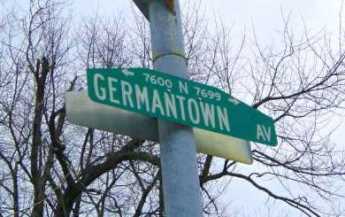
Trapped in a Casino
 There's lots to be wary of, in a casino. If you are planning to cheat, here's something you surely ought to know.
There's lots to be wary of, in a casino. If you are planning to cheat, here's something you surely ought to know.
Roebling
 Some millionaires of the 19th Century are called Robber Barons, but the Roeblings deserve to be called Titans of Industry.
Some millionaires of the 19th Century are called Robber Barons, but the Roeblings deserve to be called Titans of Industry.
Frank Furness,(3) Rush's Lancer
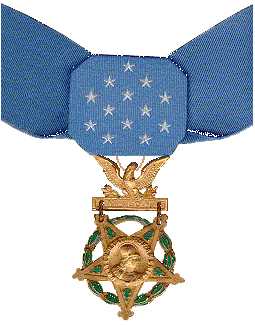 One of Philadelphia's most famous architects had two notable exploits as a Civil War cavalry officer, one of which won him the Congressional Medal of Honor.
One of Philadelphia's most famous architects had two notable exploits as a Civil War cavalry officer, one of which won him the Congressional Medal of Honor.
Frank Furness (1):PAFA
 An art museum contains a lot of art. It should itself be a work of art if it can be.
An art museum contains a lot of art. It should itself be a work of art if it can be.
Frank Furness (2) Rittenhouse Square
 There were plenty of rich folks in Philadelphia before the Civil War. But it took the industrial revolution to make possible what we call the Victorian urban mansions.
There were plenty of rich folks in Philadelphia before the Civil War. But it took the industrial revolution to make possible what we call the Victorian urban mansions.
Hospital Elevators

New Museum of Chemical Heritage
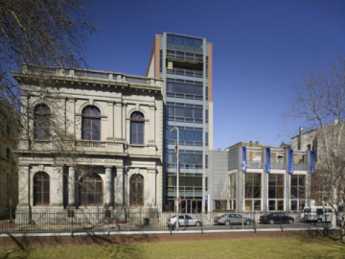 There's a stunning new museum on Chestnut Street, right across the street from Carpenters Hall. It's intended to convince everybody that chemistry is fascinating, particularly those who incline to doubt it.
There's a stunning new museum on Chestnut Street, right across the street from Carpenters Hall. It's intended to convince everybody that chemistry is fascinating, particularly those who incline to doubt it.
Water Works, Emblem of the Past
Water pollution doesn't cause Yellow Fever, but in 1799 Philadelphians thought it might, and united to make a work of art out of a new water utility. Eventually, it did eliminate Typhoid deaths.
The University City
 Ben Franklin would scarcely recognize the college he created. It isn't named for him, but he probably would be concerned about how quickly it is changing.
Ben Franklin would scarcely recognize the college he created. It isn't named for him, but he probably would be concerned about how quickly it is changing.
Pyramid-Building, Greatly Simplified
 After several thousand years, building the Egyptian pyramids might turn out to be easier than we imagined.
After several thousand years, building the Egyptian pyramids might turn out to be easier than we imagined.
Re-Doing Dilworth Plaza
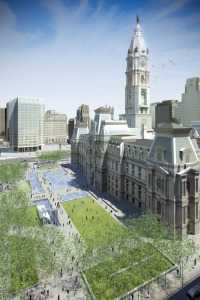 Plans are afoot to rearrange the whole focus of center-city Philadelphia, by merging the transportation network around City Hall, and changing the walking patterns. Dilworth Plaza is in the center of it all.
Plans are afoot to rearrange the whole focus of center-city Philadelphia, by merging the transportation network around City Hall, and changing the walking patterns. Dilworth Plaza is in the center of it all.
Cushman Club for Lonesome Actresses
 One of the ancient Camac Street clubs has closed its doors, to become a charitable foundation.
One of the ancient Camac Street clubs has closed its doors, to become a charitable foundation.
What's Different About Kosher ?
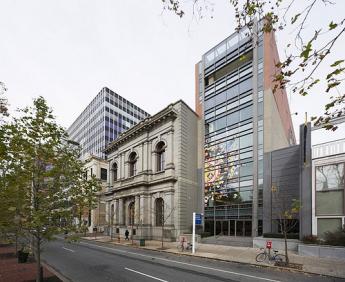 A recent conference at the Chemical Heritage Foundation examined the perplexing question of just what is signified by Kosher designation of food. Most of the curious audience were themselves Jewish.
A recent conference at the Chemical Heritage Foundation examined the perplexing question of just what is signified by Kosher designation of food. Most of the curious audience were themselves Jewish.
Existing Websites Which Offer Higher Education
The number of Internet websites which currently offer free education on the college level is immense and growing rapidly. Just as terabyte is the next step after gigabyte, we need a new word to denominate "much larger than merely immense".
Heron Rookery on the Delaware
 Two or three miles from Philadelphia City Hall, a large flock of Blue Herons with seven-foot wingspreads are nesting in the trees, largely unnoticed.
Two or three miles from Philadelphia City Hall, a large flock of Blue Herons with seven-foot wingspreads are nesting in the trees, largely unnoticed.
Bergdoll the Rich Draft Dodger

Selling Entire Towns
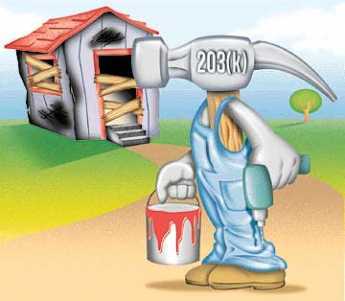 Some builders build whole towns without houses and then sell them to custom home builders.
Some builders build whole towns without houses and then sell them to custom home builders.
Greenhouses
 A greenhouse is a greenhouse, until you know something about them.
A greenhouse is a greenhouse, until you know something about them.
Serpentine Rock From Serpentine Barrens
 Nice green serpentine stone was a popular building material until its disadvantages were recognized.
Nice green serpentine stone was a popular building material until its disadvantages were recognized.
Green Roof at Peco
 That big black electric company building across from 30th Street Station has a green roof. That is, they have planted sedum on it, and it's attractive to visit. Economics is another matter.
That big black electric company building across from 30th Street Station has a green roof. That is, they have planted sedum on it, and it's attractive to visit. Economics is another matter.
Powel House, Huzzah!
 On 3rd Street in Philadelphia's Society Hill, stands the finest surviving Georgian House of what Washington and Madison called the Republican Court. A great many traditions of American high society were formed in the second-floor dining room of this house.
On 3rd Street in Philadelphia's Society Hill, stands the finest surviving Georgian House of what Washington and Madison called the Republican Court. A great many traditions of American high society were formed in the second-floor dining room of this house.
Heavenly House
 In or around Philadelphia, money no object, what's the best place to build a super-mansion?
In or around Philadelphia, money no object, what's the best place to build a super-mansion?
Ageing Owners, Ageing Property
 From Japan, we get a fresh view of our assets. Kiyohiko Nishimura observes that the price of a house, even of a stock portfolio, has something to do with the age of the owner who is selling it.
From Japan, we get a fresh view of our assets. Kiyohiko Nishimura observes that the price of a house, even of a stock portfolio, has something to do with the age of the owner who is selling it.
A Few Rooms of Your Own
 The way we live changes what we are.
The way we live changes what we are.
Relocation
 Moving your place of residence has many influences, but property taxes seem to have the biggest influence on business executives decided to move. By contrast, property prices have the biggest influence on the middle class.
Moving your place of residence has many influences, but property taxes seem to have the biggest influence on business executives decided to move. By contrast, property prices have the biggest influence on the middle class.
Peggy Shippen and Benedict Arnold: Fallen Idols
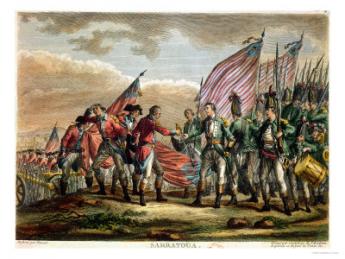 The hero of the Battle of Saratoga married the Queen of Philadelphia society, but then betrayed the country.
The hero of the Battle of Saratoga married the Queen of Philadelphia society, but then betrayed the country.
Proposal for the Parkway
 In 1986 the architect Alvin Holm proposed an amphitheater for the Parkway. It was too soon, but maybe its time is approaching.
In 1986 the architect Alvin Holm proposed an amphitheater for the Parkway. It was too soon, but maybe its time is approaching.
Glen Foerd, Torresdale, and the Feudal Industrial Style
 The owner of the many mansions of Glen Foerd was unabashedly nouveau riche, and like John Roebling, tolerated no threat to the Imperial style of industrial organization.
The owner of the many mansions of Glen Foerd was unabashedly nouveau riche, and like John Roebling, tolerated no threat to the Imperial style of industrial organization.